What is a Service Safari and how to use it
At Sutherland Labs, we have a range of methodologies that we use to help our clients explore their research, design, and business objectives. The precise methodological approach will depend on a number of factors, including the research questions/objectives, the research material, the product or service in question, timescales, and budget.
In this post, we’ll present a method we adopt when we want to understand user needs, gaps, and opportunities for a service. Called a Service Safari, it’s an exploration of a service from a customer experience perspective.
The method captures the real-world experience of a specific service, type of service, or a wider range of services, be that for booking train tickets, or a hotel or shopping mall experience, to a car hire or passport renewal service.

Starting the process

As with any project, we’ll start the project with a stakeholder meeting so that everyone can agree on the research objectives and questions, approach, timescales, and deliverables. We’ll also use this time to delve deeper into understanding the business objectives and any background to the project that could prove useful.
Harvesting data
Following the planning meeting, we put our plan of attack into action. Usually in teams of two, we’ll explore the service ourselves. If it’s a train ticket booking system, we’ll buy a ticket and go on a journey, or if it’s a shopping mall experience, then we’ll visit the shopping mall and familiarize ourselves with the services and facilities on offer.Immersing ourselves in the service is key here as we aim to experience it from the customer’s perspective.
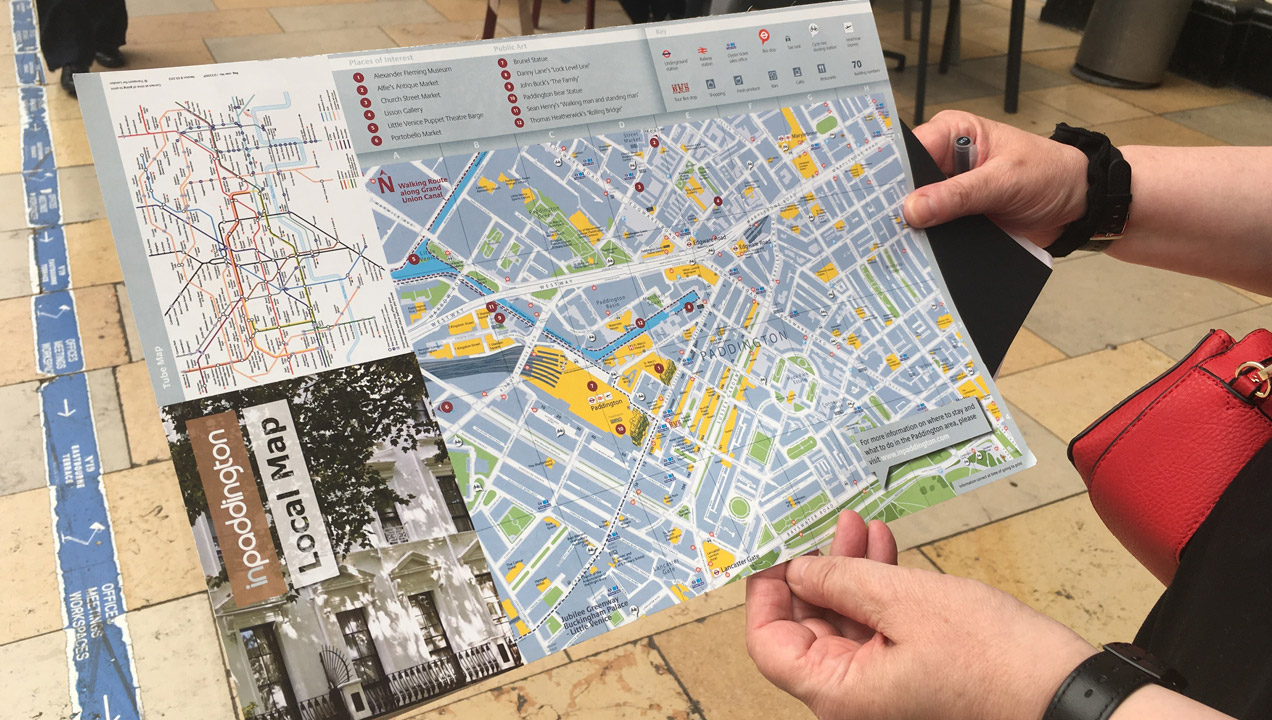
This gives us a first hand understanding of what it feels like to be a customer; what thoughts, frustrations and concerns customers might be having at each stage, and can even present new opportunities that the company can explore further.
Immersing ourselves in the service is key here as we aim to experience it from the customer’s perspective
But there’s also a more fundamental aspect to this stage of the research; it allows us to map out the various touch-points and understand how everything fits together. We’ll explore touchpoints, environments (e.g. a physical train station, kiosks, etc), websites, apps and physical artefacts (e.g. a ticket, paperwork, etc). We’ll also speak to customers, and employees, where possible, to get additional perspectives on the service.
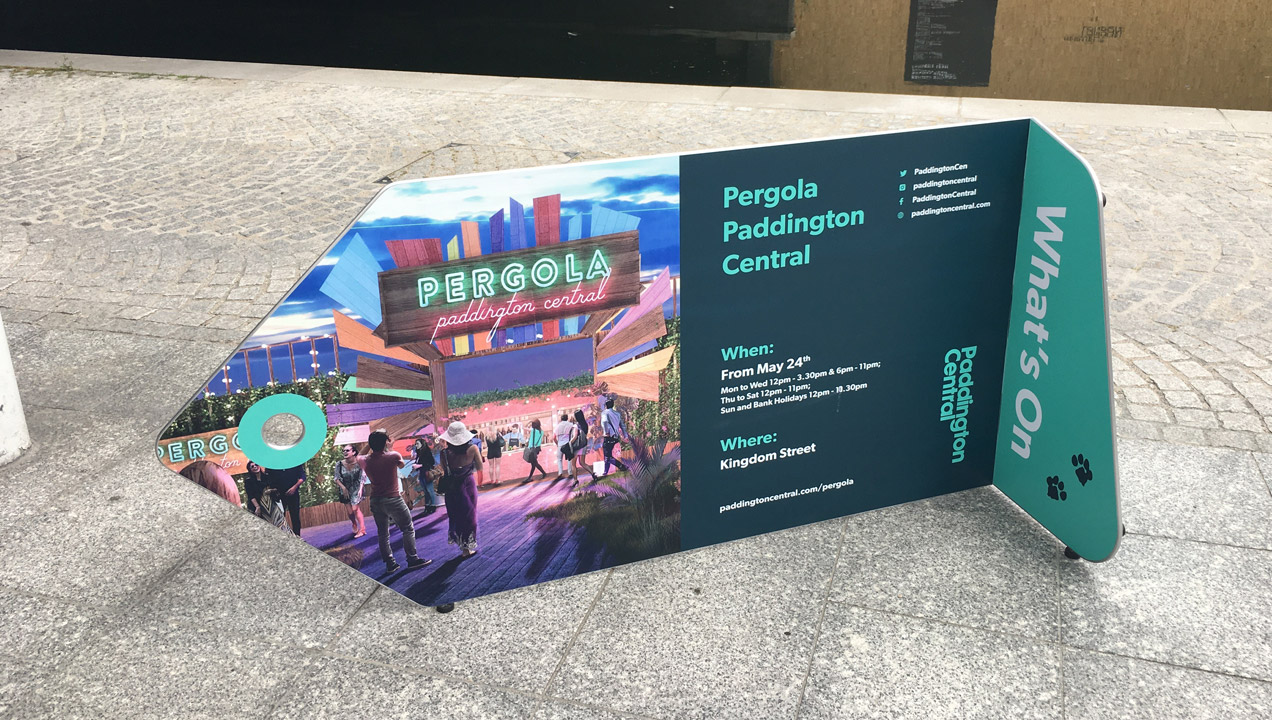
Over time, we’ll use these findings to add a canvas to the service framework until a rich picture is revealed.
We’ll capture this information in notebooks, or as pictures. We might also collect artefacts such as receipts, tickets, brochures, leaflets or any other material that we are faced with, whilst experiencing a service.
Deep-diving into the data
Once the data collection phase is complete, it’s time to review everything and look for patterns, issues, and opportunities. Having more than one researcher working on a project really helps this stage as the two can validate each other’s findings. Discussion of the data is also a great way to synthesize findings and gain deeper insights.
The precise deliverables will depend on the project, but a journey map or journey log are common outputs. We’ll use the journey map to visualize the flow of touch-points, highlighting the issues and opportunities in parallel swim-lanes. It’s a useful analytical tool for the researchers, as well as for the service designers and makes for a powerful reference tool throughout a service design project, allowing teams to consistently check how changes might affect the customer journey.
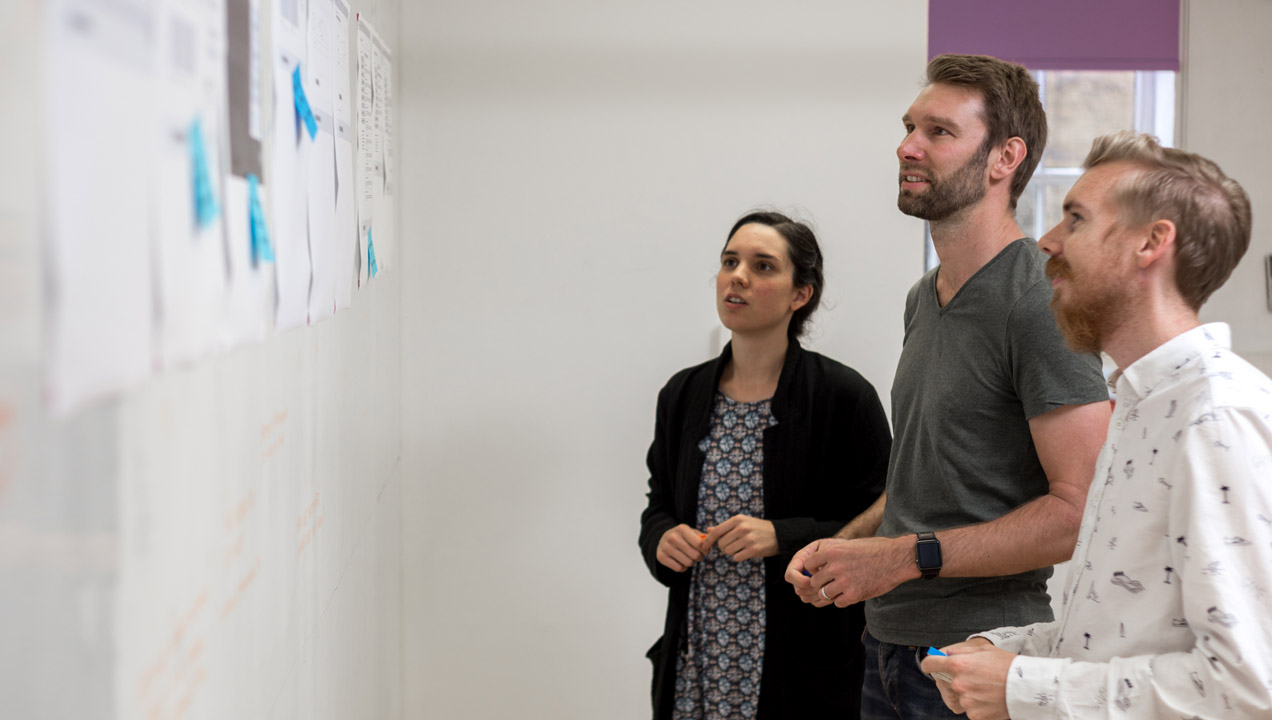
Pros and cons of a Service Safari
So when should you use a Service Safari and when might it not be appropriate? Service Safaris are great at giving you an initial understanding of the customer experience of a service. The kinds of questions it would help you answer include if you wanted to understand where the pain points are in a shopping experience, and begin to understand some of their causes. It might highlight things that competing services do particularly well in comparison to your own service. Exploring the service as customers ourselves, also helps uncover some of the workarounds that customers may employ. It’ll also help you to understand what works particularly well and could be replicated in other parts of the business.
Exploring the service as customers ourselves, also helps uncover some of the workarounds that customers may employ
However, for a deeper, more exhaustive understanding, user research is key. To explore the end-to-end journey it may be that a full ethnographic study is appropriate. Here, the researcher would spend anything up to a day with a customer (and do this with several customers), shadowing them to understand the minutiae of their experience, including motivations and any previous experiences that influence their current one.
Service Safaris are also not solely appropriate when wanting a deep understanding of specific touchpoints within a service. For example, when trying to ‘look behind the numbers’ from analytics data, to understand why a booking app might not be working optimally. In that scenario, lab-based sessions with potential customers might be a more fruitful approach, to supplement a Service Safari. One-to-one sessions allow researchers to focus on individual touchpoints, to explore issues at a finer granularity, and provide more focused recommendations.
Snr Research Director

During Mark’s 12 years of industry experience, he’s worked at several leading research labs, collaborating with global brands in the media, telecoms, finance, entertainment and the public sector. He also heads up our UX Design team, who provide our prototyping, wireframing and UI design capabilities. With degrees in Cognitive Science and Human-Centred Computer Systems, and a doctorate in Sociology, he’s a vital cog in Sutherland’s collective brainpower – and a keen cyclist and bass guitarist in his spare time.
View other blog posts by Mark
- Reviews / Why join our community?
- For companies
- Frequently asked questions
Service Safaris
What are service safaris.
Service safaris are an early qualitative research method where researchers walk in the customers' shoes to experience a service from the customers’ perspective. By experiencing the service directly, they can find strengths, weaknesses and more as they build empathy with customers early in the design process.
Frank Spillers, CEO of Experience Dynamics, provides an overview of service safaris:
- Transcript loading…
“To acquire knowledge, one must study; but to acquire wisdom, one must observe.” — Marilyn vos Savant, Magazine columnist, author, lecturer, playwright and Guinness-Book-of-Records holder of the highest-recorded IQ
In service design , designers optimize end-to-end experiences. They focus on user needs , touchpoints and seamless integration across the entire service. For example, when a customer takes the train, they encounter many service components . Some examples of components include:
They use an app to buy their train tickets .
They enter the station and look for directions to the ticket machines .
They use the ticket machine to collect their tickets .
They ask a customer service representative for information.
They look at the departure board for updated travel information .
They use their ticket to pass through the entry barriers .
They board the train and use the signs to find their seats .
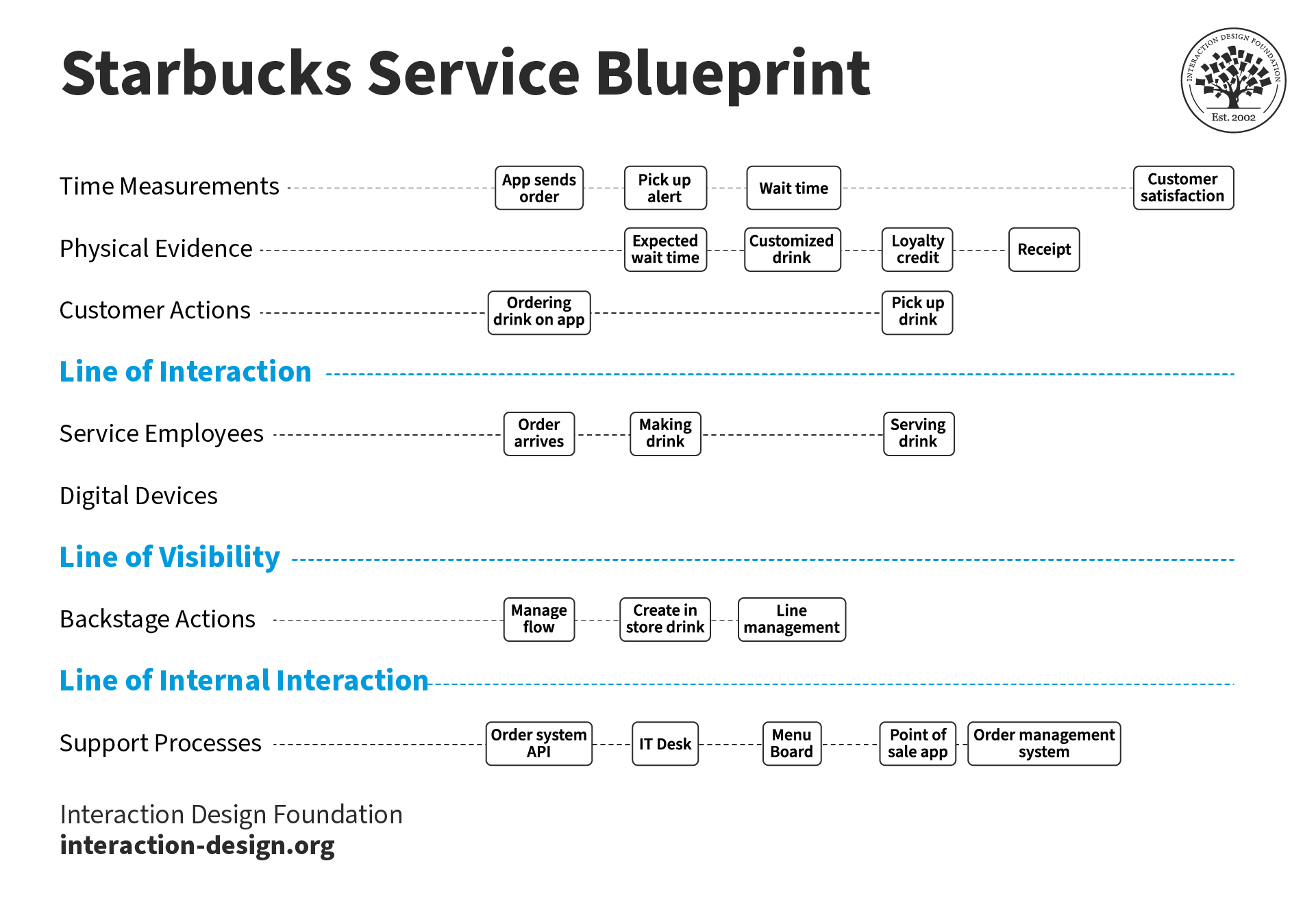
© Interaction Design Foundation, CC BY-SA 4.0
On a service safari, researchers perceive and interact with individual components and the service as a whole. Service safaris help researchers:
See, hear and feel the service's experience as a consumer, not a researcher.
Learn how a service works from the customer's perspective.
Review the service as a whole, not by individual components.
For example, in 2022 and 2023, Airbnb CEO Brian Chesky traveled across the US to stay in Airbnb rentals. He also made a room in his home available on Airbnb. Chesky discovered issues with the experience of being an Airbnb customer and a host. He used these insights to improve Airbnb’s service design.
How Do Service Safaris Improve Service Design?
Service safaris benefit service design in three primary ways:
They provide direct insight into how a service works and the customer experience . For example, a design team creates a café-oriented service involving an app. A “field trip” to Starbucks could offer a robust view of the many aspects of a well-branded coffee shop customer experience. Findings from safaris can directly inform design decisions. However, researchers must back up findings with actual user research .
They inform future research. Real-world insights help create hypotheses, guide user interviews and shape survey questions. Safaris turn observations into actionable research questions. These questions can further deepen researchers’ understanding of user needs and behaviors .
They build empathy within the design team. Researchers empathize with customers by experiencing the service as they do. This firsthand experience is invaluable for designing more intuitive and user-friendly services.
Direct Insights
When researchers venture out to get a first-hand experience as a customer, they can:
Observe real-world interactions. Researchers directly observe how customers interact with a service in their natural environment. Observations help identify pain points, moments of delight and areas for improvement. These observations might not be evident through other research methods.
Identify touchpoints . Researchers document every touchpoint where customers engage with the service. They note digital and physical interactions. Researchers must understand these touchpoints to map out the customer journey accurately.
Gather qualitative insights. Researchers collect qualitative data on their feelings, frustrations and satisfaction. This data deepens their understanding of the customer's emotional journey.
Analyze service flows. Researchers identify any inefficient processes or disconnects that could hinder the customer experience.
Influence management decisions . Researchers can present stakeholders with their findings to better convince them of the need for service design.
Future Research
Service safaris help form the basis of future user and ethnographic research . Safaris help researchers identify key customer behaviors and contexts . For example, insights from a service safari in a retail environment might highlight the following:
How consumers navigate the physical space.
The role of digital tools in their shopping experience.
Moments that lead customers to purchase decisions.
These observations can guide researchers to focus on specific behaviors, interactions or environmental factors.
Service safaris can uncover unspoken needs and pain points . For example, customers may repeatedly ask staff for directions in a supermarket. A positive experience with support staff may cause customers to overlook this as a pain point and not mention it in an interview or survey. This insight can inform the need for better signage in the supermarket.
Ann Blandford, professor of human-computer interaction (HCI), explains how user interviews help researchers discover the “why” but not the “how”:
Insights inform the recruitment of participants for ethnographic research. Service safaris can identify the most relevant user groups for a study, which allows researchers to get the most out of their research.
Observations can directly inform the development of research questions . For instance, a service safari in public transportation reveals challenges with buying tickets. Future research might explore the context and specificities of this challenge with customers.
When to Conduct Service Safaris?
Researchers conduct service safaris during the empathize stage of the design thinking process. Since safaris can form the basis of future research and help gain an overview of service, they are often the first method researchers use. They can be insightful and inspirational as researchers can research their own or other services.
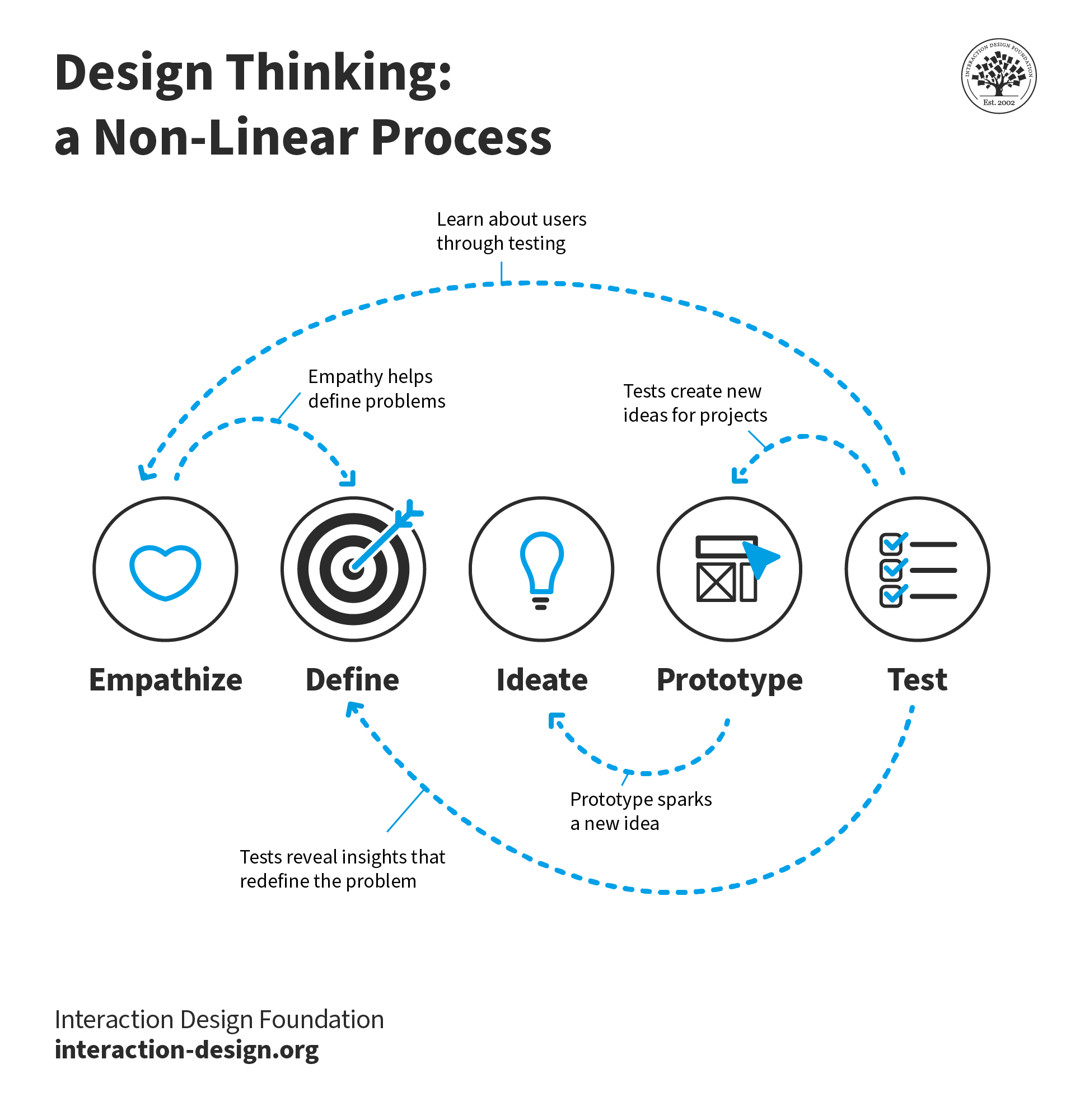
In the design thinking process, empathy helps define problems. This empathy fuels the entire design process and feeds into each stage. Early research methods like service safaris build empathy in a design team and are critical to user-centered design.
Some example scenarios in which a researcher might conduct a service safari include:
To begin the research process and map a previously unmapped service.
To research competitors or services from other industries to gain insights and inspiration.
To redesign or assess a specific aspect of a service.
To gather information that can convince stakeholders of the benefits of service design.
How To Conduct a Service Safari
Researchers conduct service safaris for both physical and digital services. For example, a digital service safari could follow the process of purchasing an item from an e-commerce website. Everything from a marketing email to delivery and contacting customer service should be part of the safari.
Required Resources
Safaris can be inexpensive and flexible.
For example, coffee shop and public transport safaris need little investment . Researchers can be reimbursed if they work for or with the service they are researching.
For some services, safaris are easy to set up and run. Researchers can conduct safaris as and when needed. Straightforward safari examples include coffee shops or digital-only safaris.
Recruiting users is unnecessary. Researchers and team members conduct the safari themselves.
Multiple team members and stakeholders can conduct service safaris for diverse insights .
Conversely, safaris can also be resource intensive:
High-cost services need more investment. Especially if the researcher is investigating rival or comparative services.
Some safaris are time-intensive —for example, a long-haul flight or a service in a remote location.
Researchers may need funding and permission from management regardless of the resources needed. Case studies and stories of successful safaris can be helpful for researchers who want to influence stakeholders.
Prepare for Your Service Safari
Once researchers have the funding and permission they need, they use the following process:
Set a goal or task a typical customer might have. In the coffee shop example, this might be to place an order in the app and pick it up at the shop.
Choose where to start the safari. While it may seem obvious where the safari will take place (e.g., a coffee shop), service design encompasses every service component. For example, when evaluating a coffee shop, the safari may begin with finding and accessing the shop. How well is its location advertised? Is its signage clear? Is it accessible to all customers?
Decide who should go. Multiple team members and stakeholders should conduct a service safari wherever possible. With several perspectives, researchers can better understand a typical experience. This approach improves empathy with and understanding of the service’s customers. However, each person must go alone. Researchers find it more challenging in a group to focus and put themselves in the customer's shoes. Group safaris can also result in groupthink , where the group’s identity overshadows individual opinions.
Decide what to bring. Researchers may take a smartphone or camera to take pictures and videos and a notebook to record observations. Items a customer would typically have are also essential. For example, researchers may take an umbrella if the service safari occurs in a restaurant and it’s raining. Researchers observe small details, like where customers can put their wet umbrellas.
Conduct the safari. Once you’ve planned your safari, the next step is to execute it. During the safari, pay close attention to the following (you can take pictures, videos and voice and written notes):
The service touchpoints and how they fit together. How do you interact with the service, and are there any problems? Do you notice any disconnects between parts of the service?
The service environment and any physical artifacts the service involves. e.g., coffee cups and seating.
Which digital interfaces do you use while you’re on safari?
Anytime you feel frustrated or confused by the service.
Crucial thoughts or feelings about the experience.
Tips and best practices
Service safaris may seem simple; however, researchers follow these best practices to get the best results:
Use empathy maps . Researchers often chart their observations on an empathy map, which can be helpful in later research and ideation. Empathy maps visually represent the researcher’s thoughts, feelings and actions. If you also spoke with other customers, you can include their thoughts, feelings and actions.
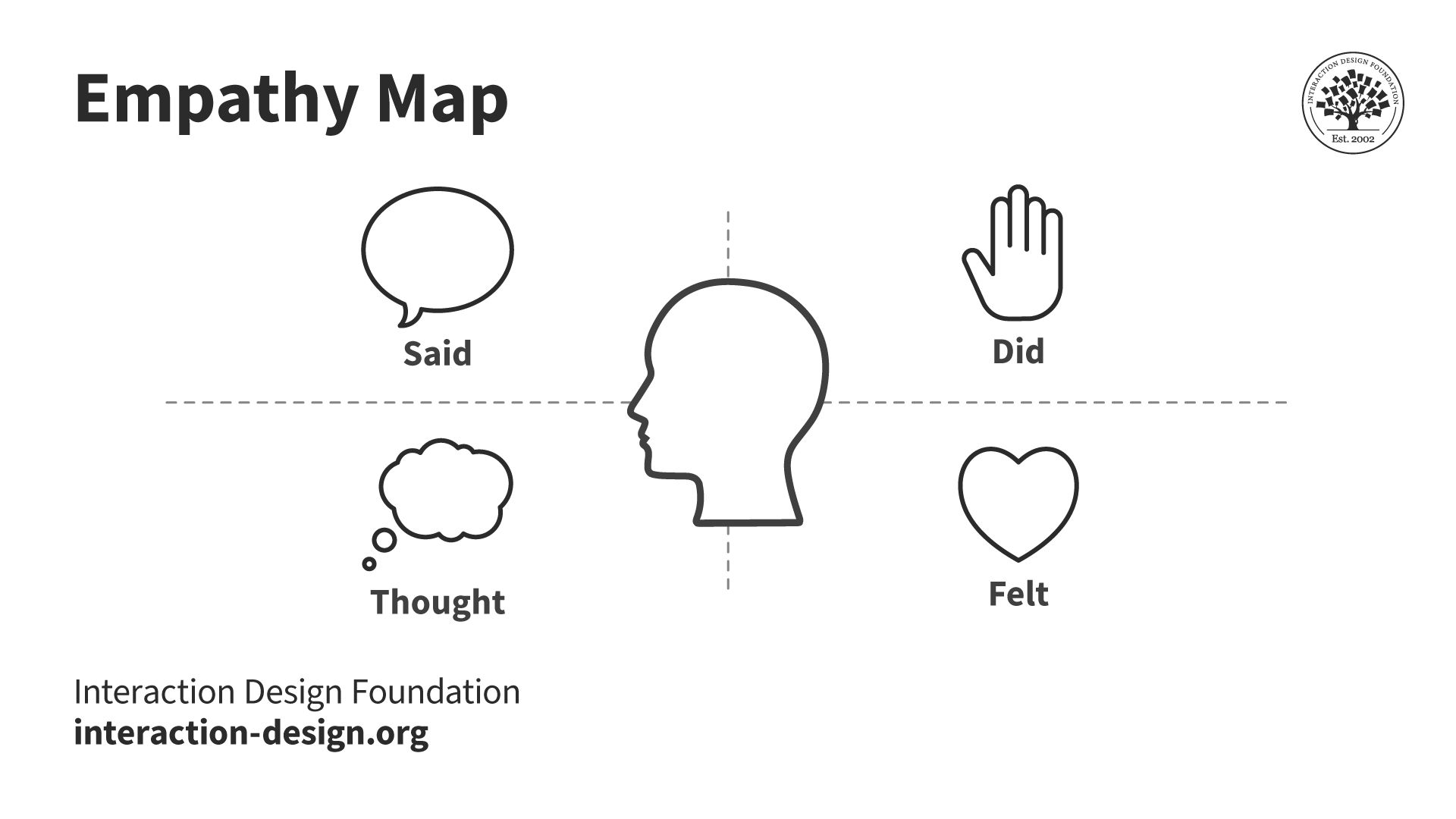
Design teams use empathy maps to inform further research, brainstorming and design decisions. Teams refer to the maps throughout the design process to stay empathetic and focus on the user.
Get comfortable with role play and prepare fictitious scenarios. Some service safaris involve everyday tasks, like buying a coffee. However, others, like applying for a loan at a bank, do not. Researchers must often role-play for a more accurate customer experience during service safaris. Prepare scenarios and backstories to ensure the service reacts to you as if you were a customer.
Immersion is key. Embody the customer or user as far as possible. Limit distractions and think deeply about the circumstances in which a customer would use the service.
Use observations to inform future research. A service safari is a foundation for ethnographic research, not a replacement. Safaris reveal issues that inform later research questions. If a service safari is the only research used, it will be biased and unreliable.
Keep an open and critical mind. An open mind is essential for stakeholders conducting service safaris of their services. Remain impartial and expect to find issues and disconnects.
Run a trial safari. A practice run can help prepare for the actual safari. A trial benefits those who’ve never done a service safari before. Trials can reveal the need for deeper role-play and better observation recording, among other pitfalls. This process will improve the outcomes of the actual safari.
Ensure privacy and consent. Service design often involves audio and video recordings. Ensure you get permission from the people you record (e.g., other customers standing in line). Secret audio or video recording violates privacy.
Service Safari Pitfalls
While service safaris are beneficial to service design, they do have some common challenges:
Familiarity with the service. It can be challenging for some team members and stakeholders to get into the customer’s mindset as they can anticipate what’s next. For example, a team member may be familiar with a train ticket machine and overlook its lack of user-friendliness because of expert knowledge. To combat this, take advantage of other team members' and customers' lack of experience and knowledge.
Bias and subjectivity. Service safaris involve personal observation and experience. While you can use techniques to limit bias, it is impossible to be completely objective. For this reason, it is vital you conduct further and deeper research with real customers.
Potential disruption. It is difficult for researchers to pretend to be a customer in some settings. For example, a researcher cannot entirely embody a patient in healthcare. Overtly observing or participating in the service as a “fake” customer can disrupt the normal service flow. Disruption can lead to less authentic observations.
Service Safari Deliverables
Service safaris provide insights that can contribute directly or indirectly (through future research) to several service design deliverables. These deliverables assist the design team throughout the service design process. They help the team build and retain empathy, make strategic decisions and maintain a holistic view of the whole service.
Customer journey maps visually represent a user's interactions with a product or service over time. Service safari insights can help researchers identify critical points within the user journey. However, researchers should create user journey maps with insights from real users, not only stakeholders. This detailed understanding allows researchers to pinpoint areas for improvement and innovation accurately.
Frank Spillers explains how journey maps fit into the service design process and how to approach them:
Personas are fictional characters researchers create based on research. They represent users who might use a product or service and help design teams remember who they are designing for. As with journey maps, service safaris should not solely inform personas. A holistic user research approach informs accurate and relatable personas.
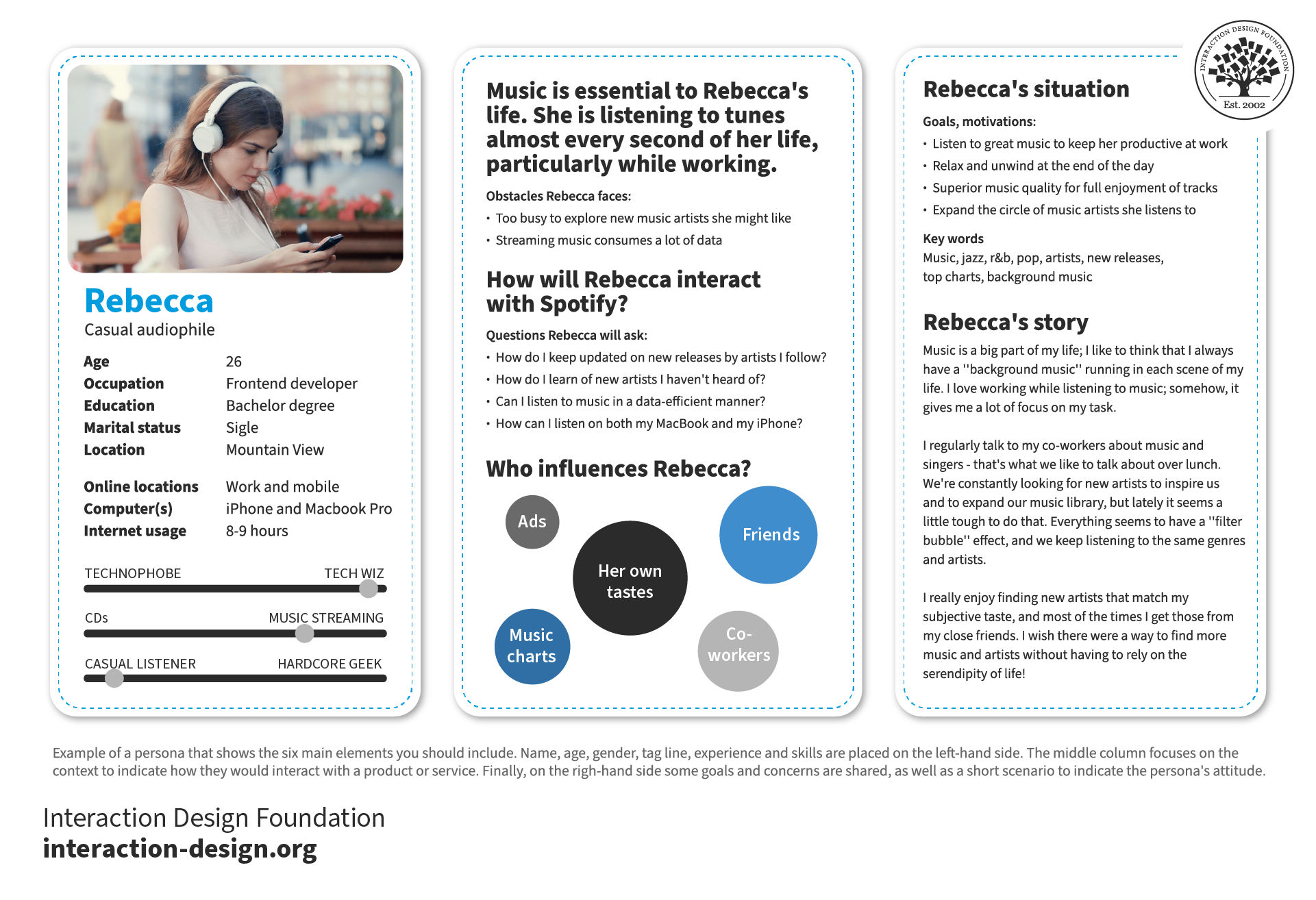
Service blueprints chart the entire service process. Blueprints include “frontstage” and “backstage” components of a service. Blueprints also include “moments,” for example, when customers browse a menu or wait for their order.
As with journey maps, safaris can inform design teams when they create their service blueprints. While safaris focus on the customer’s point of view, researchers may observe other service components. They can include these observations in their service blueprints.
David Bill, service researcher at Amazon Web Services, explains the difference between “frontstage” and “backstage” in service design:
Learn More about Service Safaris
Take our course, Service Design: How to Design Integrated Service Experiences , to learn more about service safaris and other service design research methods.
Learn more about service safaris from Frank Spillers on the Experience Dynamics website .
UX and Service Design Agency Clockwork Belgium provides a wealth of great tips and additional considerations for service safaris.
Our Master Class, Going from UX to Service Design , is ideal for those who want to move into the field.
Listen to the Nielsen Norman Group podcast with Thomas Wilson, senior principal service researcher at United Healthcare, for service design and research insights.
Questions about Service Safaris
Researchers conduct service safaris remotely for digital-only services. For example, a researcher may take the following steps on an e-commerce service safari:
Click through from an advert on social media.
Sign up for the mailing list.
Read and review the emails they receive.
Click on a promotional email to purchase an item.
Review the website for purchasing information.
Contact customer service for extra information.
Purchase the product.
Review the order and delivery information emails.
Receive the order.
Experience the packaging, information provided and finally, the product.
Interact with after-sales support (help pages, customer support, etc.)
Researchers may conduct multiple safaris since digital services include many potential customer journeys .
Researchers must also consider the following adaptations for remote service safaris:
Note taking. Screenshots and screen recordings replace or accompany photos and videos.
Customer environment. Consider different situations in which customers use the service. Examples include at home, while commuting, on mobile, on desktop, etc.
Customer interaction. Forums and chatrooms can replace in-person interactions to get customer perspectives.
Photography and videography are crucial in service safaris because they capture what happens in real time. Photos and videos help researchers:
Capture interactions with the environment, including subtle moments that might go unnoticed.
Gain a comprehensive view of the entire service journey.
Spot problems , chances for new ideas and areas that need better solutions.
Create empathy for the whole design team, even those who weren't there in person.
Serve as references for creating customer journey maps and facilitating future ideation.
Researchers do not need to be expert photographers and videographers to capture valuable information. Similarly, professional equipment is not required. Most smartphone cameras or consumer equipment are enough for service safaris.
Ann Blandford, professor of human-computer interaction, covers the pros and cons of different research collection methods in this video:
Researchers use these methods to note their interactions and observations during service safaris:
Observational notes. Researchers keep written notes, either with digital devices or pen and paper. Notes should be understandable yet brief. This approach ensures you do not interrupt the immersion required in a service safari.
Photography and videography. Researchers use photos and videos to capture moments and details that are hard to express in words. These visuals can show the setting and interactions, providing a detailed context for analysis.
Audio recordings. Researchers record conversations and background sounds. These recordings offer insights into the service atmosphere and customer feedback. They are also helpful for accurately quoting users later on.
Sketches and diagrams. Researchers sketch the layout of service areas, user paths and interaction points. These drawings help illustrate the arrangement and relationships within service experiences.
Sticky notes and flashcards. Researchers use these to easily document thoughts, observations and insights. They are handy for sorting and prioritizing touchpoints and interactions during analysis.
Each method offers a different perspective on the service experience. Often, researchers combine these techniques to provide a complete view of the service safari. Remember, you must have permission from anyone you record or photograph.
Mike Rohde, researcher, teacher and illustrator, explains sketchnotes and how they can be useful to researchers:
Learn more from Mike in his Master Class, How to Become a Visual Thinker With Sketchnoting .
Researchers use a clear and structured method to share findings from a service safari effectively. An example process is:
Summary. Begin with a short overview. Highlight the main findings and their possible effects on the service design. Summaries let stakeholders quickly understand the research's core.
User journey maps. Show the user's journey with maps. These maps should cover interactions, key points, challenges and joyous moments. Develop these maps as you conduct further research with real customers. Maps make it easier to communicate user flow problems and areas for improvement.
Storytelling with visuals. Use photos and videos from your safari to share engaging stories about interactions and service settings. This method helps stakeholders feel more connected to what you found.
Data and insights. Support your findings with data where possible. Use quotes, numbers and analysis from the safari or other research to support the need for improvement.
Recommendations. State clear, actionable suggestions for innovation. Rank these by impact and how easy they are to implement.
Interactive session. Run a session where stakeholders can directly interact with your findings. For example, include a role-play session of certain service elements to show their positives and negatives.
Q&A time. Set aside time for questions and discussions. Q&As encourage stakeholders to get involved and offer a chance to gain insights and different viewpoints.
Storytelling plays an important role in effective communication. Learn from Ellen Lupton, writer, researcher, curator and educator, the role of paths and journeys in storytelling:
Learn more from Ellen in her Master Class, Storytelling Through Visual Design: A Practical Guide .
Unsuccessful service safaris are valuable learning experiences. Researchers use them to refine research processes and improve future design outcomes. Researchers learn from unsuccessful safaris in the following ways:
Reflect on objectives and outcomes. Begin by comparing the safari's objectives against the outcomes. Identify where they separated to reveal differences to your expectations.
Analyze the methodology. Review the research methodology to identify any weaknesses or biases that may have influenced the results. Consider whether different methods or tools might have yielded more insightful data.
Review data collection tools. Examine the effectiveness of the data collection tools and techniques used. Inadequate tools can hinder the capture of relevant data, pointing to areas for improvement.
Consider external factors. Reflect on external factors that could have affected the safari, like timing or unforeseen events. Understanding these influences can help plan more resilient future safaris.
Solicit feedback. Gather feedback from team members to gain diverse perspectives on what didn’t work and why. This feedback is crucial to identify blind spots and areas for growth.
Document lessons learned. Compile the insights gained from this reflection into a lessons-learned document. Use this document to refine future service safaris and avoid similar pitfalls.
Share findings with the team. Share the lessons learned with your team and stakeholders. Discuss what went wrong and how to improve to create a culture of continuous learning and improvement.
Plan for flexibility. Recognize the importance of flexibility in research design. Incorporate contingency plans and be open to adapting the approach mid-safari to mitigate risks of failure.
Stay curious and resilient. Embrace a mindset of curiosity and resilience. Failures are stepping stones toward more effective and impactful design research.
Don Norman, emeritus professor of psychology, cognitive science and computer science, explains the importance of failure:
Researchers tailor the research focus, methodologies and participant engagement strategies for different industries. They do this in the following ways:
Customize research objectives. Define clear, industry-specific objectives. What works for a retail service safari might differ for a healthcare safari. For example, retail focuses on customer engagement and space layout. Healthcare prioritizes patient care and privacy.
Select relevant touchpoints. Identify industry-specific touchpoints and interactions critical to the service experience. For instance, digital interaction points in banking may be more relevant than in hospitality. In hospitality, personal service touchpoints are more important.
Adapt data collection methods. Use data collection methods suited to the context and goals of the industry. For example, indirect observation might be more appropriate than direct observation. Adaptability is critical in highly confidential environments like healthcare or legal services.
Incorporate expert insights . Researchers can involve industry experts or insiders in the safari. Experts help researchers understand the service context more profoundly.
Tailor reporting and analysis. Customize the analysis and reporting of findings to address the industry's strategic priorities. Highlight critical insights that can lead to competitive advantages.
Focus on sector-specific outcomes. Aim for outcomes that resonate with the industry's specific goals. Outcomes could be to streamline operations, enhance accessibility, or innovate service delivery.
Iterate and innovate. Be open to iterating the safari approach based on feedback and findings. Iteration allows for adaptations that could lead to better discoveries and deeper knowledge.
Researchers create or learn from business model canvases in new services or industries. Frank Spillers explains what business model canvases are and how to create them:
Service safaris stand out from other UX/UI design research methods because of their immersive, observational nature. This approach gives researchers deep insights into user interactions and service delivery processes. Key aspects that differentiate service safaris include:
Immersive observation. Methods like surveys and interviews rely on self-reported data. Conversely, service safaris allow researchers to witness firsthand how customers interact with services. Safaris capture nuances and behaviors other methods might not reveal.
Real-world context. Researchers conduct service safaris in the actual locations where services are delivered. This approach offers an unfiltered view of user experiences and environmental influences. Compare this to a method like usability testing. Usability testing often occurs in controlled environments and may not fully capture the use context.
Holistic service perspective. Service safaris give researchers a holistic view of the service ecosystem. This view includes touchpoints, interactions and the service environment. A broad perspective is essential for understanding complex service experiences. Meanwhile, methods like task analysis only focus on specific elements.
Empathy building. Researchers develop a more profound empathy for users as they engage directly with the service environment. This immersive experience can inspire innovative solutions grounded in real user needs. This approach contrasts with data-driven methods that might overlook a design's emotional aspects.
Service safaris can enhance the design process when combined with other research approaches. This comprehensive approach leads to more user-centered and effective service designs. Kendra Shimmell, vice president of design at Remitly, explains the importance of combining user and industry research in service design:
Researchers value observations that capture the entire customer experience and service delivery. Types of observations that are particularly insightful include:
User behaviors . Note both your actions and those of other customers. Pay attention to habits, routines and any workarounds users develop to cope with service shortcomings.
Emotional responses. Search for emotional cues that show satisfaction, frustration, confusion, or delight. Emotional responses can reveal unmet needs and areas for emotional engagement within the service.
Service touchpoints. Identify and assess all points of interaction between the customer and the service. Touchpoints include digital interfaces, physical spaces and human interactions. Understand these touchpoints to help pinpoint areas for improvement.
Pain points. Identify any difficulties or obstacles, including access barriers and usability issues you face. These insights are beneficial for future research.
Moments of delight. Record instances where the service exceeds customer expectations or provides pleasant surprises. These moments present opportunities to build upon.
User interactions. Pay attention to how customers interact with each other within the service context. Social dynamics can offer insights into user needs, behaviors and the service’s role in facilitating community.
Operational efficiencies. Note the effectiveness of the service’s operations. Observations include workflow, speed and quality of service delivery.
Comparative observations. If applicable, compare different service settings and times of day. This approach helps identify variability in the service experience. These comparisons can uncover opportunities for customization or targeted improvements.
Innovative uses. Look out for innovative or unintended ways users engage with the service. These observations can inspire new features or services.
Collectively, these observations provide a comprehensive view of the service experience. They highlight both strengths and areas for improvement. Document and analyze these insights to drive significant enhancements in service design.
To measure the effectiveness of a service safari, researchers evaluate the quality and impact of the insights gathered. Key ways researchers assess a safari’s effectiveness include:
Insight quality. Evaluate the depth, relevance and novelty of the insights obtained. When researchers conduct effective safaris, they uncover actionable insights. Insights reveal underlying user needs, pain points and opportunities for innovation.
Coverage of objectives. Measure how well the safari met its predefined objectives. Check if the safari sufficiently covered the service and customer experience and filled all knowledge gaps.
Follow-up research engagement. Check how well the safari has revealed new paths for research or found new questions to explore. An effective safari allows researchers to uncover questions and opportunities for deeper investigation.
Stakeholder feedback. Researchers gather feedback from stakeholders on how they presented the findings. Positive feedback indicates effectiveness, particularly about the insights' usefulness and presentation clarity.
Implementation rate. Track the number of insights translated into design improvements or strategic decisions. A high implementation rate shows researchers provided findings that were actionable and valued.
Impact on the design process. Evaluate how the safari influences the design process. Observe new team perspectives, empathy levels and new design practices or methodologies.
Design teams should evaluate these aspects step by step. This process helps them check how well their service safaris work and continue the improvement of their research methods.
One of the most important outcomes of a service safari is increased empathy with the customer. Learn how empathy affects good and bad design in this video:
Literature on Service Safaris
Here’s the entire UX literature on Service Safaris by the Interaction Design Foundation, collated in one place:
Learn more about Service Safaris
Take a deep dive into Service Safaris with our course Service Design: How to Design Integrated Service Experiences .
Services are everywhere! When you get a new passport, order a pizza or make a reservation on AirBnB, you're engaging with services. How those services are designed is crucial to whether they provide a pleasant experience or an exasperating one. The experience of a service is essential to its success or failure no matter if your goal is to gain and retain customers for your app or to design an efficient waiting system for a doctor’s office.
In a service design process, you use an in-depth understanding of the business and its customers to ensure that all the touchpoints of your service are perfect and, just as importantly, that your organization can deliver a great service experience every time . It’s not just about designing the customer interactions; you also need to design the entire ecosystem surrounding those interactions.
In this course, you’ll learn how to go through a robust service design process and which methods to use at each step along the way. You’ll also learn how to create a service design culture in your organization and set up a service design team . We’ll provide you with lots of case studies to learn from as well as interviews with top designers in the field. For each practical method, you’ll get downloadable templates that guide you on how to use the methods in your own work.
This course contains a series of practical exercises that build on one another to create a complete service design project . The exercises are optional, but you’ll get invaluable hands-on experience with the methods you encounter in this course if you complete them, because they will teach you to take your first steps as a service designer. What’s equally important is that you can use your work as a case study for your portfolio to showcase your abilities to future employers! A portfolio is essential if you want to step into or move ahead in a career in service design.
Your primary instructor in the course is Frank Spillers . Frank is CXO of award-winning design agency Experience Dynamics and a service design expert who has consulted with companies all over the world. Much of the written learning material also comes from John Zimmerman and Jodi Forlizzi , both Professors in Human-Computer Interaction at Carnegie Mellon University and highly influential in establishing design research as we know it today.
You’ll earn a verifiable and industry-trusted Course Certificate once you complete the course. You can highlight it on your resume, CV, LinkedIn profile or on your website.
All open-source articles on Service Safaris
Customer journey maps — walking a mile in your customer’s shoes.
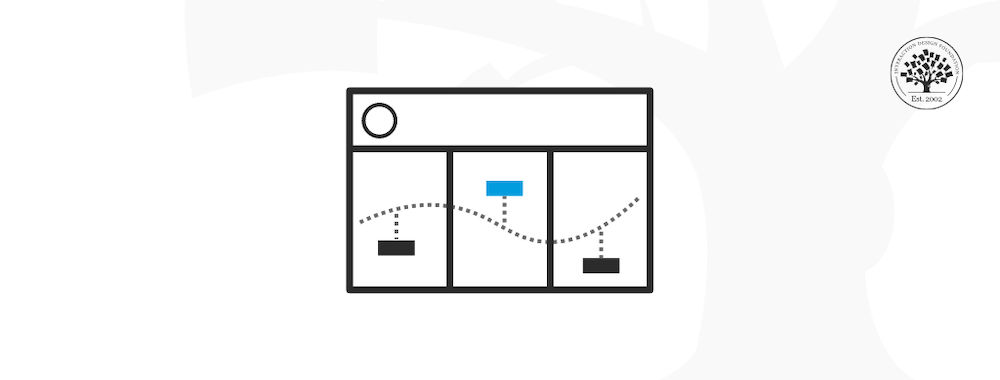
- 1.1k shares
- 10 mths ago
Service Design - Design is Not Just for Products

Understand the Service Design Process
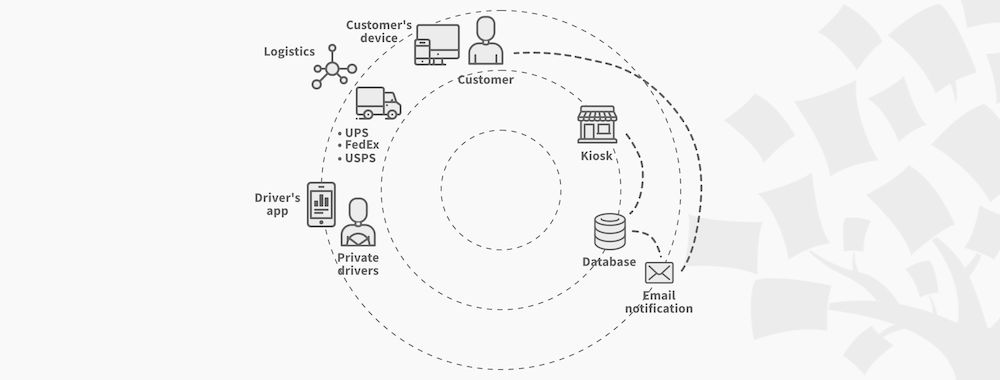
- 2 years ago
Learn the Language of Service Design
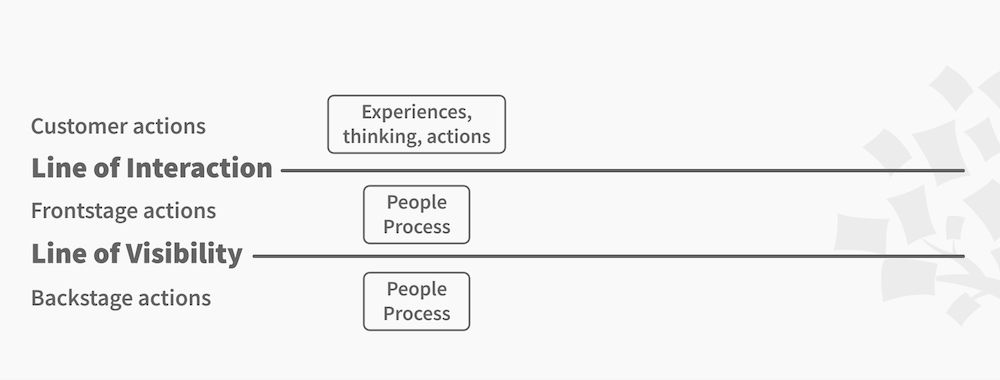
Open Access—Link to us!
We believe in Open Access and the democratization of knowledge . Unfortunately, world-class educational materials such as this page are normally hidden behind paywalls or in expensive textbooks.
If you want this to change , cite this page , link to us, or join us to help us democratize design knowledge !
Privacy Settings
Our digital services use necessary tracking technologies, including third-party cookies, for security, functionality, and to uphold user rights. Optional cookies offer enhanced features, and analytics.
Experience the full potential of our site that remembers your preferences and supports secure sign-in.
Governs the storage of data necessary for maintaining website security, user authentication, and fraud prevention mechanisms.
Enhanced Functionality
Saves your settings and preferences, like your location, for a more personalized experience.
Referral Program
We use cookies to enable our referral program, giving you and your friends discounts.
Error Reporting
We share user ID with Bugsnag and NewRelic to help us track errors and fix issues.
Optimize your experience by allowing us to monitor site usage. You’ll enjoy a smoother, more personalized journey without compromising your privacy.
Analytics Storage
Collects anonymous data on how you navigate and interact, helping us make informed improvements.
Differentiates real visitors from automated bots, ensuring accurate usage data and improving your website experience.
Lets us tailor your digital ads to match your interests, making them more relevant and useful to you.
Advertising Storage
Stores information for better-targeted advertising, enhancing your online ad experience.
Personalization Storage
Permits storing data to personalize content and ads across Google services based on user behavior, enhancing overall user experience.
Advertising Personalization
Allows for content and ad personalization across Google services based on user behavior. This consent enhances user experiences.
Enables personalizing ads based on user data and interactions, allowing for more relevant advertising experiences across Google services.
Receive more relevant advertisements by sharing your interests and behavior with our trusted advertising partners.
Enables better ad targeting and measurement on Meta platforms, making ads you see more relevant.
Allows for improved ad effectiveness and measurement through Meta’s Conversions API, ensuring privacy-compliant data sharing.
LinkedIn Insights
Tracks conversions, retargeting, and web analytics for LinkedIn ad campaigns, enhancing ad relevance and performance.
LinkedIn CAPI
Enhances LinkedIn advertising through server-side event tracking, offering more accurate measurement and personalization.
Google Ads Tag
Tracks ad performance and user engagement, helping deliver ads that are most useful to you.
Share Knowledge, Get Respect!
or copy link
Cite according to academic standards
Simply copy and paste the text below into your bibliographic reference list, onto your blog, or anywhere else. You can also just hyperlink to this page.
New to UX Design? We’re Giving You a Free ebook!

Download our free ebook The Basics of User Experience Design to learn about core concepts of UX design.
In 9 chapters, we’ll cover: conducting user interviews, design thinking, interaction design, mobile UX design, usability, UX research, and many more!
New NPM integration: design with fully interactive components from top libraries!
How to Do a Service Safari in 5 Easy Steps
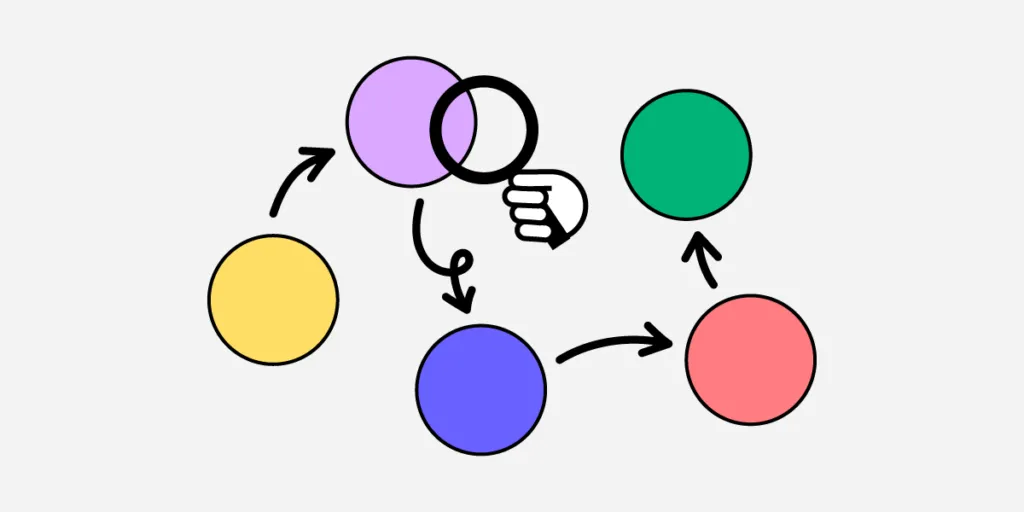
A service safari allows design teams better to understand competitors, users, and their own product. This service experience offers valuable insights for very little investment, making it an essential tool during the early stages of the design thinking process .
This article looks at the pros and cons of a service safari, how to plan and run one, and what you can expect from the results.
Design, prototype, test, and iterate with the world’s most advanced code-based design tool. Sign up for a free trial to discover how UXPin can revolutionize your UX projects.
Build advanced prototypes
Design better products with States, Variables, Auto Layout and more.

What is a Service Safari?

A service safari is a real-world research method where designers experience a product as a user–like mystery shopping. You can conduct a service safari on your product, competitors’, or both. The process works for physical products, services, and digital products.
During a service safari, team members complete various tasks to gain insights into the product’s customer experience.
A service safari is a valuable UX design research method because it’s inexpensive (for most digital products), and teams can complete the process without users.
Who Does a Service Safari?
Usually, various team members from a design project participate in a service safari. Participating in a service safari gives team members valuable insights into the competition, but the process also provides an opportunity to empathize with users from a product-usage perspective.
When to do a Service Safari?
UX designers complete service safaris during the discovery phase of a design project when researching competitors or evaluating an existing product for a redesign. They use the results to identify opportunities and pain points that help guide the design process .
The Purpose of a Service Safari
Here are some common reasons design teams conduct service safaris:
- Understand the competition and their services
- Determine the quality of service (competitors and internally)
- Identify new business opportunities
- Identify user pain points and areas for improvement
- Gain a user’s perspective to empathize better
Pros and Cons of a Service Safari
- Pro: Great for improving empathy for customers
- Pro: Gain a first-hand understanding of the competition
- Pro: Helps validate or understand other research
- Con: Risk of bias from team members too familiar with the product
- Con: Getting into the customer’s mindset is difficult when you can anticipate what will happen next
- Con: Without clear objectives, results can be ambiguous
5 Steps for Conducting a Service Safari

The level of planning for a service safari will depend on the product or service you’re evaluating. For example, a travel booking app will require taking a flight, while a productivity app you can experience from the office.
Step 1. Meet With Team Members & Stakeholders
Meeting with stakeholders before a service safari is essential to agree on the approach, budget, business goals, timeline, and deliverables.
Next, you want to meet with the team taking part in the safari, create a plan, define the methods, outcomes, and assign tasks. Your team will also need to gather the necessary tools and materials like stationery, devices, tools, etc.
Step 2. Set Clear Objectives
Setting clear and actionable objectives is crucial in planning a service safari. These objectives will ensure team members understand each task and its outputs/deliverables.
Design Principal at ustwo in the UK, Hollie Lubbock, recommends pairing a research question with a goal to create a clear objective mission statement – objective = research question + goal .
For example:
- Question: “How do we open a new bank account using a competitor’s app? What are the current options, hacks, and issues with achieving this goal?”
- Goal: “Understand the highs, lows, and friction points in this experience.”
Step 3. Define the Documentation Process and Deliverables
How do you want team members to document their service safari experience? Some examples include:
- Notes (written, voice, etc.)
- Screenshots/screen recordings
- Photos and videos
Hollie Lubbock recommends you outline “key areas to document.”
- The experience over time: Pre/during/post
- What or who you encounter: People/processes/objects/ environments/places/communications
Hollie also gets team members to gather their general impression of the experience, like:
- How much time does it take to complete the task?
- Is it easy to complete?
- Are there clear instructions or options?
- Did you hit any dead ends? Or experience any errors?
Answering these questions provides valuable insights about the product and enables team members to empathize better when developing a solution later in the design process.
Step 4. Conduct the Service Safari
Depending on the product, a service safari could take a few hours or several weeks. Kate Greenstock’s service safari of Jelf Insurance Brokers’ UK offices took eight weeks to complete .
The most important part of running a service safari is documenting the process according to your objectives. We recommend taking lots of notes, screenshots, recordings, etc., so you don’t miss anything.
Hollie Lubbock created this free Google Doc for documenting your service safari.
We also recommend checking out Preety Naveen’s Service Safari With Skycash –a Polish-based payment service. Preety created a three-step process for each step of her Skycash service safari:
- Actions: The actions she took in each step
- Problems: The problems resulting from each action
- Recommendations: Suggestings to improve each step
A service safari aims to experience every touchpoint from a user’s perspective. Sutherland Labs’ service safari gives an example of exploring touchpoints for a train booking service:
- Booking website/app
- Visiting the station, getting on the train, etc.
- What happens at the turnstiles?
- What’s the physical ticket office like?
- Physical artifacts (tickets, maps, etc.)
The team from Sutherland Labs also takes the opportunity to speak to people, including staff and customers, to get different perspectives. For example, if you’re designing a train booking app, how do people with disabilities experience the service? What are their pain points?
While a service safari is primarily about you experiencing the service, it’s ultimately about finding a solution for customers , so take the opportunity to speak to other users and ask questions. This inquisitive approach could provide valuable usability and accessibility insights.
Step 5. Synthesizing the Results
An affinity map works best when analyzing notes from a service safari. You’ll need a whiteboard (or digital alternative for remote collaboration) and sticky notes.
- Create headings for each step in your service safari–i.e., open the app, create an account, etc. If you’re analyzing products from several competitors, these steps might differ.
- Write your raw notes for each step onto sticky notes and paste them under the relevant heading.
- As a group, identify patterns, key issues, and opportunities.
- Create a journey map to visualize your results and guide your next decisions.
It’s important to note that you must never use a service safari as a standalone piece of research. Design teams must cross-reference the results with other data or use it to guide and validate further user research.
Using Service Safaris to Prototype in UXPin
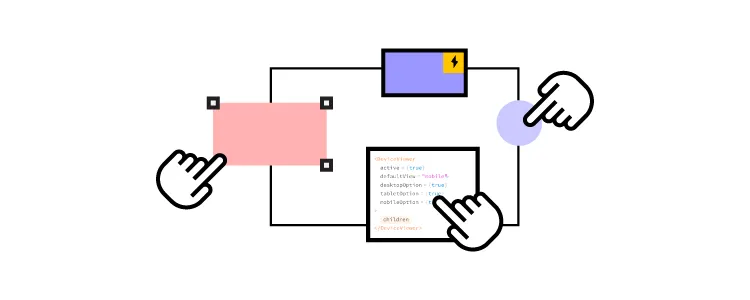
Building prototypes is an excellent way to test recommendations and hypotheses after a service safari. UXPin’s built-in design libraries , like Google’s comprehensive Material Design UI , enable designers to build prototypes, test ideas, and iterate fast!
Instead of presenting just a customer journey map or report to stakeholders, designers can build a quick prototype in UXPin, and use it to get buy-in for their solution.
Enhanced Collaboration
Whether you’re working in the office or part of a remote team, UXPin’s Comments enhance collaboration between design teams . Multiple designers can simultaneously work on the same project to design wireframes, mockups, and prototypes.
Adding Stakeholders and Collaborators
Did you know you can share your UXPin projects with stakeholders , experts, consultants, and other collaborators who don’t have a UXPin account?
These stakeholders can view your designs and prototypes, leave comments, and approve from anywhere–perfect for today’s remote work environments. You can even include a message with your approval , so stakeholders know what they’re reviewing for approval. UXPin also integrates with Slack and Jira , allowing you to discuss projects in one place.
Streamlined Design Handoffs
Design handoffs are a stressful time for designers and engineers. Miscommunication, lack of documentation, and poor-quality prototypes cause friction between teams.
Because UXPin is a code-based design tool, designers can replicate code-like functionality and fidelity, while Spec Mode gives engineers context and documentation to begin the development process, including:
- Inspecting Properties : Inspect the properties of any element or component, including its size, grid, colors, and typography.
- Distance Measurement : Measure distances between elements or the canvas edges.
- Style Guide : Details about the project’s styles, including colors, typography, and assets.
Designers can also create documentation with labels for each element to provide engineers with context and explanations–no more external PDFs or attachments!
If you’re still using outdated image-based design tools to design, prototype, and test, it’s time to switch to UXPin–the world’s leading code-based design solution. Sign up for a free trial and start designing better user experiences for your customers today!
Build prototypes that are as interactive as the end product. Try UXPin

by UXPin on 24th May, 2022
UXPin is a web-based design collaboration tool. We’re pleased to share our knowledge here.
UXPin is a product design platform used by the best designers on the planet. Let your team easily design, collaborate, and present from low-fidelity wireframes to fully-interactive prototypes.
No credit card required.
These e-Books might interest you

Design Systems & DesignOps in the Enterprise
Spot opportunities and challenges for increasing the impact of design systems and DesignOps in enterprises.

DesignOps Pillar: How We Work Together
Get tips on hiring, onboarding, and structuring a design team with insights from DesignOps leaders.
We use cookies to improve performance and enhance your experience. By using our website you agree to our use of cookies in accordance with our cookie policy.
Service Safari
Dive into a service experience in first-person, applied for.
Prototyping
Service Staff
also called
Mystery shopping, Auto-ethnography
related content
Observation Notes
Research Plan
Journey Map
Service Safari is a research tool that helps designers develop interesting insights and inspirations by experiencing a service in first-person, as they were ‘in the shoes’ of a user. While pretending to be a user, designers can understand in detail all the aspects of the interaction with the service, observe how other people in the same space/environment behave, and eventually intercept the opinions and perceptions of other users. After having gone through the service, journey maps help generate a documentation of the experience that can be used for ideation and comparison purposes. Often times, the safari could be replicated going through the competitors’ service as well.
Develop a complete first-hand understanding of the service experience, before further research investigations.
remember to
Set a clear protocol for the observation and immersion, to be carefully followed along the journey.
case studies
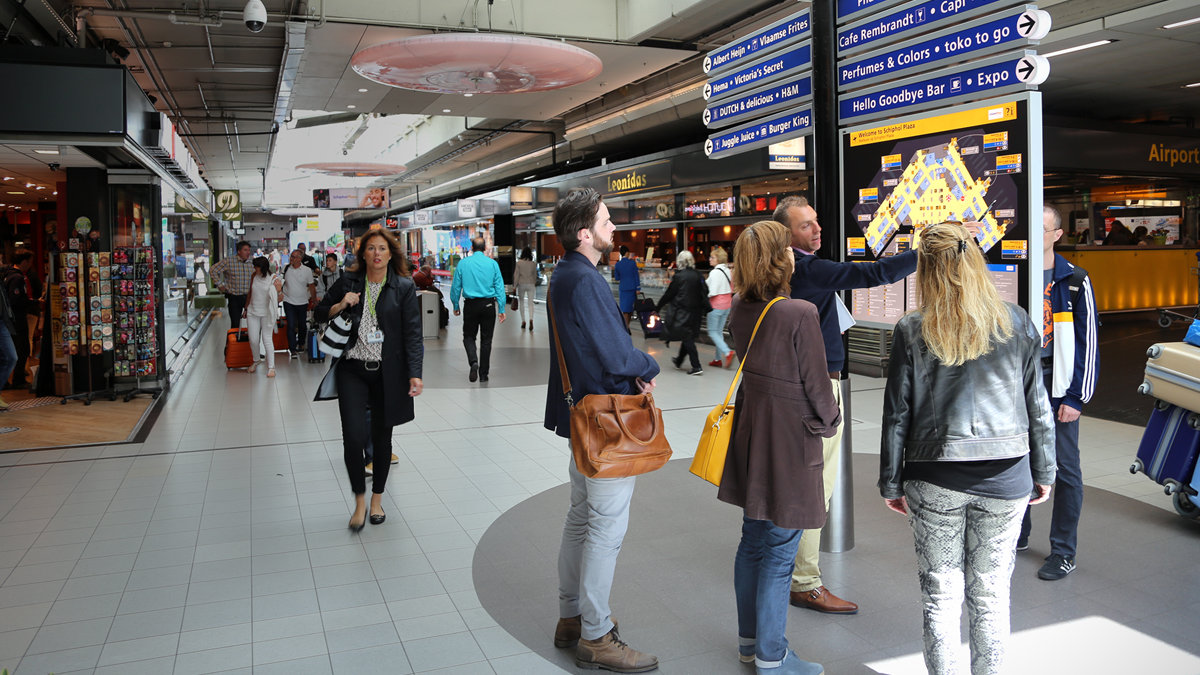
Example by Essense
Designing Schiphol Airport experience
Understanding the experience of an international airport from travellers' perspective
description
Essense worked closely with the Consumer Marketing team at Schiphol Group (Amsterdam Schiphol Airport) to develop a customer experience vision for all touch-points of the entire passenger journey across digital and physical channels, from buying a ticket to boarding a plane. After a first map of the customer as-is journey based on desk research, existing insights and learnings were validated and enriched through a two-day ‘service safari’ at Schiphol Airport with the respective client ‘area experts’ (parking, prior to security, after security). The service safari confirmed lots of the learnings previously developed but also clearly showed that there was little synergy between the three core airport areas, which appeared as three different silo experiences.
what is interesting
The Service Safari helped the entire team to develop a holistic understanding of passenger’s experience and the ecosystem at the airport, bringing the findings from the as-is journey to life. This led also to additional learnings about the context and commercial playing field (such as parking competitors near the lounge, external security personnel, etc.) that would have otherwise been missed.
Grow with us! Share your case studies
The collection is always evolving, following the development of our practice. If you have any interesting tools or example of application to share, please get in touch.
This website uses cookies to collect anonymized usage statistics so that we can improve the overall user experience. If you want to know more or change your preferences, read our Cookie Policy . By clicking Accept you are giving consent to the use of cookies.
No, thank you.

Introduction to Service Safari
Coming from a design strategy background, I always have a keen interest in one of the design thinking methodologies called Service Safari. Service safari is a prominent design methodology amongst service designers, but recently, UX researchers have also found this methodology quite useful. Service Safari is an exploration of service from a customer experience perspective. This methodology is best used at the very beginning of the design process to understand the real-world experience of a product, service, and product or service provided by competitors and collaborators in the industry.
By using service safari, researchers would be able to gain insight on real user’s pain points, opportunities in the market, and service benchmarks. It is crucial for strategists and UX designers to immerse themselves in using the service from the customer’s shoes. They will have a better understanding of what it feels like to be a customer, what frustration, concerns, and motivation that stops or drives them from using a product or service.
Before starting the Service Safari process, design researchers are recommended to have a stakeholder meeting to decide on the research objective, approach, and timeline. The meeting will also help researchers to be on the same page to plan on a specific service or journey to explore. The key to a clear objective is to pair a research question with a goal. e.g., We want to understand (how to create an extraordinary experience for users when they are going to a cinema). The research objective is used to understand the highs and lows (standards) of what a service and how each experience is being evaluated using those standards.
Having more than one researcher working on service safari is essential because each researcher can validate each other’s findings. Service safari is usually conducted by a small team of two to four researchers. The duration of a service safari can last from a day, weeks, or even a month, depending on the chosen product/service and the research objective.
Once researchers have a clear objective, they should decide on what service or product that they would investigate, it can also be the brand’s competitors and collaborators. Creating a planned scenario is also recommended so that researchers will not wander too far away from the research objective. Each scenario should include:
- What users are looking or trying to do, and why?
- What interactions will they encounter during the process?
- What is the end goal of the journey?
As researchers are conducting the service safari, they should document their findings by using a camera, notebook, or a service safari spreadsheet. Documentation is vital for stakeholders to understand each pattern, pain point, and opportunity found during the research. At the end of the process, the researcher can create an analysis and report based on their notes and documentations. The output of the research can be a journey map or post-it notes on an affinity map. From my previous experience in conducting a service safari, I prefer a journey map to outline all the pain points and opportunities discovered during the research. It is also a great way to synthesize findings from other researchers and gain deeper insights.

To conclude this, service safari is a fast and easy-to-use design methodology for stakeholders to understand where their service or product stands in the market. However, this method should not be a substitute for user research; nevertheless, it can be used as a supplementary research approach.
https://www.100open.com/toolkit_2/service-safari/
https://blog.prototypr.io/how-why-and-when-to-run-a-successful-service-safari-accbf8f32e55
Service Safaris: Understand How Corporate IT is Really Used
What is a Service Safari and how to use it
What I Learned from a Service Safari
D Service Safari Methodology for Impactful UX Research
Por Redacción Aguayo
Discover how the Service Safari methodology can provide valuable insights to improve your projects, from planning to execution. Get ready to embark on a journey of observation, data collection and analysis that will transform your approach to UX research.

Introduction to Service Safari
User experience (UX) research is an essential component in developing user-centric products and services. In this context, Service Safari emerges as a unique and effective methodology to thoroughly understand how users interact with services throughout their journey.
What is Service Safari?
Service Safari is a research technique involving direct observation of users as they interact with a specific service. Unlike other research methodologies, Service Safari focuses on user experience in real-world situations, allowing researchers to capture valuable and authentic insights.
Main Objective: Detailed Observation
The main goal of Service Safari is to conduct a detailed and non-intrusive observation of how users interact with a service from start to finish. From entering the service to exiting, each interaction and touchpoint is meticulously recorded to understand user emotions, challenges, and highlights.
Basic Steps to Conduct a Service Safari:
- Service Selection: Identify the specific service to be investigated.
- Team Formation: Recruit a team of researchers who will conduct the observation.
- Detailed Planning: Establish a detailed plan that includes observation points, schedule, and key metrics.
- Field Observation: Conduct direct observation following the established plan.
- Data Collection and Analysis: Record and analyze the data collected during the observation.
Benefits of Service Safari:
- Realism and Authenticity: By observing users in real situations, authentic and realistic information is obtained.
- Problem Identification: Allows the identification of issues and challenges that users face during interaction with the service.
- User-Centered Design: Facilitates the design of solutions centered on the real needs and expectations of users.
Research Objectives
Establishing clear objectives is crucial for the success of any user experience research, and Service Safari is no exception. When undertaking a Service Safari, researchers aim to achieve several objectives that go beyond simply observing user interaction. Here are the fundamental objectives of research using the Service Safari methodology:
- Understand User Experience:
Gain a deep understanding of how users experience a specific service from start to finish.
- Identify Points of Friction:
Discover any points of friction or difficulty that users may encounter during their interaction with the service.
- Capture Highlight Moments:
Record positive and standout moments that contribute positively to the user experience.
- Evaluate Expectation Fulfillment:
Assess the extent to which the service meets or exceeds user expectations.
- Analyze Interaction Sequence:
Analyze the sequence of interactions to understand the logic and flow of user experiences.
- Identify Improvement Opportunities:
Identify areas where the service can be improved to better meet user needs and expectations.
- Validate Previous Findings:
Validate and complement previous research findings to obtain a more comprehensive and accurate picture.
- Inform Design Decisions:
Provide actionable insights that inform design decisions and enhance the usability of the service.
Preparation and Planning
Before embarking on a Service Safari, it is essential to undertake thorough preparations and careful planning. These initial steps are crucial to ensure that the research is conducted efficiently and that the obtained results are valuable and applicable. Here are the key aspects of preparation and planning for a successful Service Safari:
- Define the Research Scope:
Clearly establish the boundaries and scope of the research, identifying the specific service to be analyzed.
- Select the Research Team:
Recruit a team of researchers with complementary skills, including observers and individuals responsible for documentation.
- Train the Team:
Provide detailed training on the Service Safari methodology, ensuring that all team members understand the objectives and execution.
- Develop a Detailed Plan:
Create a plan that includes specific observation points, the schedule for the research, and key metrics to be evaluated.
- Identify Relevant Metrics:
Determine specific metrics to be measured during observation, such as waiting times, positive and negative interactions, among others.
- Equipment and Resources:
Ensure that the team has the necessary equipment, such as cameras, field notebooks, recorders, to effectively record observations.
- User Consent:
If necessary, prepare consent forms to obtain approval from users participating in the observation.
- Simulations and Pilot Tests:
Conduct simulations and pilot tests before the full observation to identify potential issues and refine the plan.
- Establish Communication Protocols:
Set clear communication protocols within the team to ensure effective coordination during the research.
- Contingency Plan:
Develop a contingency plan to address any unforeseen issues that may arise during observation.
- Ethical Evaluation:
Conduct an ethical evaluation to ensure that the research is conducted ethically and respectfully towards users.
Execution of the Service Safari
The execution phase of the Service Safari is the heart of the research, where the team observes and documents the user experience in real-time. Execution requires precision, attention to detail, and the ability to adapt to changing situations. Here are the key steps for the successful execution of a Service Safari:
Active Observation:
- Team members must actively participate in observation, capturing significant details and taking detailed notes.
Data Recording:
- Use prepared tools and resources to record key data, such as waiting times, notable interactions, and user feedback.
Team Coordination:
- Maintain constant communication within the team to coordinate observations and share discoveries in real-time.
Adaptability:
- Be flexible and adaptable to adjust to changes in the situation, allowing for a comprehensive capture of the user experience.
Respect for Privacy:
- Respect user privacy and follow established ethical protocols during observation.
Media Capture:
- If planned, use media such as photographs or recordings to enrich documentation.
Continuous Evaluation:
- Continuously evaluate the collected data to identify patterns, trends, and improvement opportunities.
Minimal Interaction:
- Minimize team interaction with users to ensure natural and non-intrusive observation.
Flexibility in Approach:
- Adapt the observation approach according to circumstances to capture valuable information.
Take Note of Immediate Insights:
- Take note of immediate insights to share with the team and begin forming preliminary analyses.
Useful Tools and Resources
Having the right tools and resources is essential to maximize the effectiveness of a Service Safari. Here are some useful tools and resources that can enhance execution and documentation during the research:
Digital Field Notebook:
- Use digital field notebook applications for quick note-taking and adding photos or recordings directly.
Audio Recorders:
- Record conversations and ambient sounds to capture details that might go unnoticed during observation.
Screen Recording Apps:
- Employ apps that record the device screen to capture digital interactions in detail.
Cameras or Video Cameras:
- Use cameras to visually document specific aspects, such as the layout of spaces or physical interactions.
Prepared Evaluation Forms:
- Have pre-configured evaluation forms to systematically record specific metrics.
Data Analysis Software:
- Use specialized software to analyze collected data and extract significant patterns.
Quick Evaluation Cards:
- Prepare quick evaluation cards with scoring scales to assess the user experience in real-time.
Maps and Diagrams:
- Create real-time maps or diagrams to visualize the user experience more comprehensively.
Mobile Devices and Tablets:
- Use mobile devices for observation, enabling effective mobility in different scenarios.
Collaborative Documentation:
- Use collaborative documentation platforms so that the team can share observations and analysis in real-time.
Data Analysis and Results
After the execution phase, the next crucial step is data analysis and interpreting the results. During this stage, the team reviews the observations, notes, and collected data to extract patterns, identify trends, and gain a deep understanding of the user experience.
The analysis involves:
- Pattern Identification: Look for recurring patterns in user behavior, common issues, or standout moments during interaction.
- Data Categorization: Organize information into thematic categories, facilitating understanding and identifying areas for improvement.
- Creation of User Personas or Profiles: Develop user profiles based on observations to better understand the needs and expectations of different segments.
- Problem Prioritization: Classify problems or areas for improvement based on their impact on the user experience and the feasibility of solutions.
- Insight Generation: Extract valuable insights that can inform design and strategic decisions.
It is crucial not only to quantify data but also to contextualize and understand the "why" behind the observed behaviors.
Benefits and Challenges
- Deep User Understanding: Service Safari provides an enriching view of user experiences in real-world environments, allowing a deeper understanding of their needs and behaviors.
- Idea Generation for Improvements: Direct observation reveals areas of opportunity and potential improvements, driving creative idea generation to optimize the user experience.
- Hypothesis Validation: It allows the validation or refutation of previous hypotheses about user behavior and design focus areas.
- Authentic Feedback: Obtain authentic and unfiltered feedback directly from users, providing a genuine perspective on their experience.
Challenges:
- Time and Resources: Executing a Service Safari may require significant time and resources, especially if conducted in extensive physical environments.
- Subjectivity in Interpretation: Data interpretation can be affected by the observer's subjectivity, highlighting the importance of having a diverse team for multiple perspectives.
- Scale Limitations: For companies with a broad user base scattered geographically, conducting Service Safaris on a large scale can be challenging.
- Need for Contextualization: Results must be carefully contextualized, as observations may vary depending on the specific moment and circumstances.
Discoveries and Insights for Immersive UX Research
After immersing ourselves in the Service Safari methodology, valuable discoveries and key insights unfold for those seeking to enrich their UX research. Direct immersion in real-world environments unveils unique perspectives, and here we share the conclusions arising from this deep exploration.
Key Discoveries:
- Emotional Connection: On-site observation allows capturing users' emotional connection with a product or service authentically.
- Identification of Pain Points: Critical points in the user experience that might go unnoticed in more controlled testing environments are revealed.
- Inspiration for Creative Solutions: Immersion inspires creative solutions by visualizing the real challenges users face.
Suggestions for Future Research:
- Team Diversification: Include a variety of perspectives in the observation team to enrich data interpretation.
- Integration with Other Methodologies: Combine the Service Safari with other research techniques for a more comprehensive understanding.
- Adaptability in Digital Environments: Explore ways to apply the essence of the Service Safari in digital environments for remote research.
Thinking about working on a project? Write to us, and we'll help you out.
About work, workshops, creative processes, new clients, old clients, daily life, and UX, epistemological thoughts, and critiques.

A/B/C Testing: Enhance Your User Experience
A/B/C testing , also known as split testing, is a fundamental technique in the world of user experience (UX) design and digital marketing. It enables businesses to evaluate the effectiveness of different design elements, content, and features to make data-driven decisions and enhance conversions. In this article, we'll delve deep into what A/B/C testing is, when you should conduct it, why it's essential, and how to effectively conduct these tests to optimize the user experience and increase your conversion rates.
- A/B Testing
- Best Practices
- Conversion Optimization
- A/B Testing,
- Split Testing
- User Experience

Types of Usability Testing: Strategies for Evaluating the User Experience
In the world of digital design and development, usability is crucial for the success of any product. Usability testing is an essential tool that allows the evaluation of how users interact with a product and how effective their experience is. In this article, we will explore various types of usability testing, highlighting effective strategies to enhance the user experience.
- User Testing
- Testing Strategies
- Digital Strategies

Prototype Testing: Enhance Your Design Before Launch
Discover the significance of prototype testing in the user experience design process. Learn when and how to implement it, the types of prototypes, and key steps for effective testing.
- enhance design
- enhance ux design
- prototype testing

Lean UX: Redefining User Experience Strategy
Explore Lean UX methodology in-depth based on the book by Jeff Gothelf and Josh Seiden. Discover its core principles, benefits, implementation process, and how it compares to other design methodologies. Learn when and who should use Lean UX to enhance user experience strategy.
- ux strategy
- lean methodology
- user experience strategy

User Stories and Use Cases: Defining UX Requirements
Discover the essential differences between user stories and use cases in user experience (UX) design. Learn how to apply each approach to define effective requirements and enhance your design skills with practical examples.
- User Stories
- User Experience Design
- UX Requirements

Information Architecture: Shaping the User Experience
Discover how information architecture shapes and organizes the user experience in website and app design. Learn best practices for structuring information intuitively, facilitating navigation, and enhancing usability and user satisfaction.
- Website Navigation
- Information Design
- Information Architecture

The Crucial Role of Ethnography in UX Research
Discover how ethnography goes beyond observation to delve into cultural contexts, enriching UX research. We will explore its process, definitions, and it seamless integration in the UX design implementation.
- User-Centered Design
- UX Research

Scaling Your Business with Akeneo: Strategies for Growth and Efficiency
Scalability is one of the biggest challenges that growing companies face. Managing a large amount of product information, maintaining data consistency and quality, and expanding into new markets are complex tasks. This is where Akeneo, a leading Product Information Management (PIM) solution, plays a vital role. Let's see how Akeneo can be the centerpiece in your business's growth and efficiency strategy
- Product Information Management

The Powerful Alliance of User Experience (UX) and Brand Strategy for Business Growth
In today's business landscape, User Experience (UX) and brand strategy are two essential elements for growth and success. In this article, we will delve into how these two disciplines can form a powerful alliance to propel your business forward. Through tangible examples and effective strategies, we will explore how a solid UX can be the key to building a strong brand and, ultimately, accelerating business growth.

What is a DXP Platform like Liferay?
Discover the Power of Digital Experience Platforms (DXPs) and Their Role in Creating Exceptional Online Experiences. A DXP like Liferay provides integrated tools and services for managing, personalizing, and optimizing digital interactions for customers, employees, and other stakeholders. From content management and user segmentation to omnichannel experiences and analytics, DXPs simplify the creation and delivery of personalized content. Leading companies in various industries, such as Vodafone, Audi, and Unilever, have harnessed the potential of DXPs to manage multiple websites, ensuring consistency and delivering seamless user experiences. Explore how DXPs can transform your digital presence and elevate customer engagement to new heights.

User Experience: Televisa optimizes its website with Aguayo
Aguayo collaborated with various departments within the Televisa Group and Univision, a media conglomerate whose largest shareholder is Televisa, on the user experience (UX) centered redesign of Las Estrellas, Televisa Espectáculos, Televisa Noticias, and Canal 5 . Furthermore, Aguayo also ventured into other projects for the Mexican company, such as the microsite for the 2018 FIFA World Cup and Fusión México, both also based on UX.

Benchmarking Competition: Improving User Experience
Discover how competition benchmarking can drive user experience improvement. Learn to identify key competitors, select effective metrics, and apply data-driven strategies to perfect your web and app design.
- Competition Analysis
- Competition Benchmarking
- UX Competitors
- UX Enhancement

User-Centered Design: Methodologies for Solving UX Problems
In an increasingly competitive digital world, User Experience (UX) and a User-Centered Design has become a critical factor for the success of any website or application. Good UX not only attracts visitors but also keeps them engaged and satisfied. However, tackling challenges and solving UX-related problems can be a complex process. Fortunately, there are effective methodologies that can assist you in addressing and resolving these issues efficiently. In this article, we will explore some of the best methodologies for enhancing UX and optimizing your website with real-world examples.
- user-center design

Data Analysis: User Behavior Patterns and Trends
In today's competitive digital world, User Experience (UX) has become a critical factor for the success of any website or application. A good UX not only attracts visitors but also keeps them engaged and satisfied. However, tackling challenges and solving UX-related problems can be a complex process. Fortunately, there are effective methodologies that can help you address and resolve these issues efficiently. In this article, we will explore some of the best methodologies to enhance UX and optimize your website with real-world examples.

Identification of Emotions: Forge Deeper Connections with Users through Emotion-Driven UX
It's not enough for websites and applications to merely function; they must also connect with users on a profound emotional level. The field of User Experience (UX) design recognizes the significance of emotions and how they influence user behavior and decisions. This understanding has given rise to emotion-driven UX design, a methodology focused on creating digital experiences that trigger and respond to user emotions.

User Experience Maps: Visualizing Key Interactions
In the world of User Experience (UX), where user satisfaction is paramount, having effective tools is crucial to understand and improve interactions between users and your website or application. One of the most valuable resources is the user experience map , also known as User Journey or Customer Journey. In this comprehensive guide, we will delve deep into how to create and use user experience maps to enhance an exceptional experience for your users and the success of your digital project.
- Customer Journey
- user journey
- Journey Map
- user experience
- User Experience Maps

Web Accessibility: Creating an Inclusive Experience
Learn how web accessibility benefits not only people with disabilities but also enhances the experience for all users on your site. Explore strategies for effective implementation and real-world examples of sites that have achieved exceptional accessibility.
- accessibility

Mastering Mobile UX: Best Practices for Seamless Smartphone Experiences
Learn the best practices for creating seamless mobile user experiences (UX) with real-world examples and in-depth explanations of key terms.

User Interface Design (UI) vs. User Experience Design (UX): Differences and Synergies
Let's break down in a simple and clear way the differences between User Interface Design (UI) and User Experience Design (UX), and how they work together to create exceptional digital experiences that captivate users.
- user interface

Omnichannel User Experience: Navigating Between the Physical and the Digital
In the ever-evolving landscape of user experience and digital development, one concept that has gained prominence is the convergence of physical and digital worlds. This convergence, often referred to as "omnichannel," represents a significant shift in the way businesses and individuals interact with technology. Let's explore the intriguing intersection of physical and digital realms and its impact on the user experience.
- user interaction
- digital transformation
- omnichannel

The Power of User Experience Maps: Optimizing Your Website
Navigating a website is not always a straightforward journey. Visitors can feel lost, confused, or simply frustrated. How can you understand what users experience on your site and improve their journey? The answer lies in User Experience Maps (or User Journeys). These powerful tools allow you to visualize users' journeys through your site, identify issues, and optimize every step.
- user journey map
- user experience maps

Design Thinking: Creating Innovative User Experiences
Discover how Design Thinking, a user-centered methodology, can drive the creation of innovative and outstanding user experiences. Explore its phases, techniques, and examples in this comprehensive article.
- problem solving
- design thinking

Heuristic Evaluation: Detect and Improve Usability Issues
Discover how heuristic evaluation can be your ally in identifying and solving usability problems in your web or application design. Learn how to apply this technique to enhance the user experience.
- Heuristic Evaluation
User Personas: Effective Tools and Practices
Discover how to build effective User Personas for your design project. Explore key tools and practices to understand your users and enhance your product's user experience.
- user persona
- user personas

Card Sorting: Designing a More Intuitive Information Structure
Discover how card sorting , a User Experience research technique, can help you create a more intuitive information structure on your website or application. Learn the steps, types, best practices, and tips here.
- card sorting
- ux methodology

Personalization in Liferay: Crafting Unique User Experiences
In today's competitive digital landscape, personalization has become a key factor in captivating users and fostering their loyalty. In this article, we will explore how the Liferay platform excels in creating unique user experiences through personalization strategies.
- Content Personalization
- personalization
- Optimization

Key Performance Metrics in Digital Development: What to Measure and Why
In the vast realm of digital development, measuring performance is paramount for success. This article delves into the key metrics that should be the focus of your attention. Discover why these metrics are essential and how they can transform your approach , from loading speed to user retention. Join us on a journey through digital analytics to empower your development strategy.
- Key Metrics
- Digital Transformation
- Site Performance

Design Systems: The Key to a Consistent User Experience
In the dynamic field of design, design systems have emerged as a revolution redefining how we create digital experiences. A design system is a cohesive set of rules, principles, and components working in harmony to build visually consistent and functionally efficient interfaces.
- Design System
- Digital Design

The Role of UX Research in Digital Development
User Experience (UX) Research stands as a fundamental pillar in digital development, acting as the process that allows us to thoroughly comprehend the needs, behaviors, and expectations of users. At its core, UX research seeks to unravel the mysteries surrounding human interaction with digital products and services, providing valuable insights for design and continuous improvement.
- Digital Development
- UX Strategies
- Research Methods

Eye Tracking and Neuro UX: Deciphering User Psychology
Let's explore into the fascinating realms of Eye Tracking and Neuro UX – two powerful disciplines that uniquely allow us to unravel the psychology of user interaction. From tracing the user's gaze to deciphering how their brain responds, we unlock the secrets behind digital engagement. Get ready to embark on a journey beyond the visual surface, where each click unveils an unseen narrative of preferences and behaviors.
- Eye Tracking
- User Psychology

The Psychology of Color in Digital Design: Strategies for an Impactful Experience
Dive into theworld of color psychology in digital design , where each shade and hue has the power to influence users' emotions and perceptions. Let's explore strategies beyond aesthetics, unraveling the fundamental theories of color, its application in branding, and how it directly impacts user behavior. From readability on digital screens to cultural considerations and practical tools, discover how colors go beyond the visual, shaping impactful and meaningful digital experiences.
- Design Strategies
- Color Psychology

From Research to Action: Integrating UX Findings in Development
Let's explore how UX research findings become the engine that drives digital development. From identifying user needs to implementing effective solutions, each stage of the process will be guided by valuable insights, demonstrating the importance of turning information into action.
- Integration of Findings

Key Strategies to Improve User Experience
Improving the user experience goes beyond simple adjustments. It involves a comprehensive approach that ranges from deep user understanding to continuous impact assessment. In this guide, we'll explore key strategies that can transform the way users interact with your digital products.
- Responsive Design
- Web Development

Winning Strategies in the Product Life Cycle: Lessons from the Boston Consulting Group
Explore the winning strategies that steer products towards success in every phase of their life cycle. This article unravels valuable lessons offered by the Boston Consulting Group (BCG), showcasing analytical tools, strategic models, and effective tactics to navigate the diverse stages. From inception to decline, discover how to implement proven strategies that have propelled the growth of prominent businesses.
- Boston Consulting Group
- Product Life Cycle
- Business Development
- Product Strategies

Efficient Integration of ChatGPT in User-Centered Design
In user-centered design, integrating ChatGPT presents exciting opportunities. Explore efficient strategies to incorporate this powerful artificial intelligence tool into the creation of more intuitive and personalized digital experiences.
- Artificial Intelligence


The Nielsen Norman Group Theory: Why Testing with Only 5 Users Matters
Delve into the Nielsen Norman Group's theory, a cutting-edge perspective challenging the need for large samples in usability testing. Discover why only 5 users are needed for meaningful and efficient results.
- Nielsen Norman Group
- Evaluation Methods

When and How to Use Empathy Maps to Transform Your Design Approach
Explore the world of empathy maps and discover how this tool can revolutionize your design approach, providing a deep understanding of your audience and enhancing decision-making.
- Empathy Maps
- User Research
- Design Tools

The Evolution of Design Methodologies: From Waterfall to Agile
- Design Methodologies
- Agile Design
- Product Development

What are the Nielsen's 10 Usability Principles?
Exploring usability principles is essential for creating effective digital experiences. In this article, we will delve into the 10 Usability Principles proposed by Nielsen Norman Group, a crucial reference in the design world. These principles provide solid foundations for the development of user-friendly interfaces.
- Usability Principles

4 Key Aspects for Effective UX Research
Dive into the fascinating realm of user experience (UX) research with our 4 key aspects . Discover how to optimize your design processes, understand your audience, and create digital experiences that truly resonate with users.
- Usability Improvement
What is the PURE Method for Usability Evaluation of a Digital Product?
In the fast-paced world of digital design, where user experience stands as an undeniable cornerstone, usability evaluation methodologies become crucial tools. Among these, the PURE Method (Pragmatic Usability Rating by Experts) stands out, a creation of the renowned Jakob Nielsen, a pioneer in usability discipline. This pragmatic approach has revolutionized the way we evaluate the interaction between users and digital products.
- PURE Method
- Usability Evaluation

'The Design of Everyday Things' by Donald Normann: Key Lessons for Sensible Design
In this article, we will explore the fundamental lessons that this influential book offers for achieving sensible design in our everyday life. From the psychology of design to the importance of visibility and feedback, immerse yourself in the keys that will transform your perspective on the world around you.
- Experiencia de Usuario
- Donald Normann
- Psicología del Diseño

Difference Between a Flowchart and Sitemap: Essential UX Design Guide
In the world of UX design, the visual representation of processes and structures is essential. Two key tools in this industry are Flowcharts and Sitemaps . Although they share the purpose of clarifying complexity, each has a unique focus. In this guide, we will explore the crucial differences between a Flowchart and a Sitemap, offering a detailed insight so you can choose the right tool at each stage of your design project.
- Diagramming

Likert Scale for UX Surveys: Optimizing Data Collection
In the realm of user experience (UX) research , the Likert scale emerges as a vital tool to capture user perceptions and attitudes. In this article, we will delve into how to implement and leverage this scale in UX surveys, maximizing data quality and providing valuable insights for the continuous improvement of products and services.
- Likert Scale

What is a roadmap and what is it for?
Discover everything about the concept of a roadmap, its historical evolution, and how it has transformed into an essential compass for achieving success in project planning and execution.
- Strategic Planning

Design Sprint: Methodology and Stages
Immerse yourself in the world of the Design Sprint and learn about its key stages. From problem definition to user testing, discover how this methodology drives innovation and streamlines the design process.
- Prototyping
- Design Methodology
- Design Sprint

User Experience and Customer Experience: Differences and Similarities
In the universe of design and business strategy, User Experiences (UX) and Customer Experiences (CX) play fundamental roles. Discover the differences and similarities in this blog.
- Business Design
- Customer Experience

The Power of Retention: Exploring Strategies from the Book 'Hooked'
In this article, we will delve into the fundamental strategies outlined in Nir Eyal's book 'Hooked,' immersing ourselves in the fascinating realm of retention and the psychology behind habit formation in products and services.
- User Experience Strategy

Storytelling in UX: Crafting Unforgettable Experiences
Explore the transformative power of storytelling in experience design . Embark on a journey where compelling narratives intertwine with user experience, forging unforgettable connections.
- Storytelling
- Narrative Design
- User Interface

Interviews with Users and Focus Groups: Pros and Cons
Learn about the advantages that user interviews and focus groups offer in experience design, as well as their limitations.

HEART Methodology: A Framework for Measuring UX
Discover how the HEART Methodology has become a powerful framework for measuring and improving User Experience (UX).
- HEART Methodology

Polarity Mapping: Framework to Enhance UX
Explore how Polarity Mapping can revolutionize your UX design approach by identifying and optimizing the polarities that impact user experience. Learn how to apply this innovative framework and enhance the quality of your products and services.
- Polarity Mapping
- UX Framework

Differences between UX Designer and UX Writer: Roles and Responsibilities
Explore the key differences between a UX Designer and a UX Writer, understand their roles, responsibilities, and discover how they collaborate to create exceptional user experiences.
- UX Designer

User Experience Strategy: Keys to Implementation in Digital Projects
- Digital Strategy
- Digital Project

Redefined Transparency: Crafting Authentic and Powerful Content
- Content Strategy
- Transparency
- Story Telling

User Experience Strategies in the World of Finance
Discover how UX strategies are transforming the financial sector, from innovation in user interface to building trust through transparency.
- UX in Banking

WCAG Short Guide: Web Accessibility
Discover how to implement accessibility standards and design websites that are accessible to individuals with diverse abilities and needs. Learn more information here: https://www.w3.org/
- Inclusive Design
- Web Accesibility
- Digital Accesibility

Sustainable Product Design: Building a Resilient Future
Explore how sustainable product design can contribute to building a more resilient future, balancing human needs with environmental preservation
- Sustainable Design
- Sustainability

User Experience Strategies in the Travel Industry
Explore the user experience strategies that are redefining how we interact with the travel industry.

How User Experience Drives Go-to-Market: Key Strategies
Discover how the synergy between User Experience (UX) and Go-to-Market strategy can be a decisive factor for success in launching products and services.
- Go-to-Market
- Go-to-Market Strategy

UX Research: When to Use Research Methods?
Explore when it's appropriate to employ research methods in the field of User Experience (UX) to optimize the design and functionality of your digital products.

The Vital Role of Alt Text in UX: Beyond Accessibility
Discover how Alt Text is not only essential for web accessibility but also plays a vital role in enhancing the user experience.
- Digital Content
- Accesibility

APIs and User Experience: Unveiling the Technological Harmony
Dive into the fascinating realm of API integration and uncover how this technological harmony enhances user experience.
- Data Integration

CMS vs. DXP: Understanding Differences and Similarities
Dive into the complex landscape of CMS and DXP to grasp key differences and uncover surprising similarities. Which is the better fit for your digital project?
- Digital Experience Platform
- Digital Platform
- Content Management

Unveiling How "Timing" Influences User Experience (UX)
Dive into the concept of "timing" and its pivotal role in user experience (UX). From the psychological perception of time to practical strategies for enhancing interaction, we'll explore how finding the perfect moment can make a difference in digital design.

Cynefin Framework: Guide for making intelligent UX decisions
Discover how to effectively leverage the Cynefin Framework to make smarter decisions in user experience (UX) design and innovation of digital products.
- Cynefin Framework

Tree Testing vs. Card Sorting: Understanding the Differences for Improved Usability
Explore the key differences between Tree Testing and Card Sorting in usability evaluation. Enhance user experience and optimize navigation in your digital projects.
- Tree Testing
- Card Sorting
- UX Evaluation

Phygital: The Perfect Blend of Digital and Physical Worlds
The term "Phygital" emerges as the key to a revolutionary user experience. Discover how the seamless integration of the digital and physical is transforming the way we live, interact, and forge meaningful connections.
- Technological Innovation
- Online Experience
- Digital Integration
- Offline Experience

Insights vs. Findings: Unveiling the Essence of Smart Research
Discover how the concepts of "Insights" and "Findings" are fundamental and drive strategic decision making, transforming data into actionable knowledge.
- Research Methodologies

'Jobs to be Done': How to Discover and Satisfy Customer Needs
Discover how to identify and address customer needs through the "Jobs to be Done" strategy. This innovative approach focuses on understanding what motivates customers to "hire" a specific product or service and how you can effectively meet those needs, ensuring exceptional customer experience and long-lasting competitive advantage.
- Jobs to be Done
- Customer Needs
- Business Strategy

Sitemap vs Information Architecture: Differences and Similarities
In web design, both the sitemap and the information architecture play key roles in organizing and structuring a site. However, although they are often confused, each has its own purpose and focus. In this guide, we will explore the differences and similarities between these two fundamental tools and their impact on user experience.

Double Diamond Methodology in User Experience: Process and Applications
Explore how the Double Diamond Methodology has become a popular framework for designing effective user experiences. We'll delve into its process and applications across various design projects.
- Design Process
- Double Diamond
- Methodology

Unlocking Creativity: Strategies to Develop Your Potential
Discover how to unleash your creativity and enhance your innovation potential with these practical and effective strategies to develop your creative abilities.
- Creatives Strategies
- Personal Development
- Inspiration

UX Innovation in Healthcare: Patient-Centered Digital Tools
Explore how UX innovation is transforming healthcare by centering its digital tools on improving the patient experience. We'll delve into trends, success stories, and challenges in this exciting journey towards the future of digital health.
- Digital Tools
- UX Innovation
- Patient Experience
- UX in Healthcare

Neuroscience and UX: Unveiling Cognitive Influence on User Experience
Explore the intersection of neuroscience and experience design, unraveling how the user's brain influences UX decisions. Discover science-based strategies to enhance your design.
- Neuroscience
- Cognitive Science

Growth Marketing vs Growth Design: Unpacking Strategies for Business Expansion
Explore key strategies driving business expansion, unraveling the differences between Growth Marketing and Growth Design, and how they can collaborate for effective growth.
- Growth Design
- Expansion Strategies
- Growth Marketing

Usability vs User Experience: The Battle for Priority
Discover how to balance the importance of usability and user experience in digital product design to achieve success.

The Role of UX Researcher in User Testing: Strategies and Approaches
Discover how the UX researcher plays a crucial role in planning, executing, and analyzing user testing, applying various strategies and approaches to enhance the user experience. user experience in digital product design to achieve success.
- UX Researcher

Gamification in Digital Product Design: Strategies to Enhance User Experience
Explore how gamification is revolutionizing digital product design and enhancing user experience. Discover effective strategies to increase engagement and interaction on digital platforms.
- Gamification
- Digital Product Design

Digital Marketing Strategies with ChatGPT
Discover how to use ChatGPT to optimize your digital marketing strategies, automate tasks, and generate persuasive content efficiently.
- Digital Marketing Strategies
- Digital Marketing

Frontend vs. Backend and Their Influence on UX
Understanding the differences between Frontend and Backend is crucial for enhancing User Experience (UX). We explore how these two parts of web development impact the way users interact with digital products.
- Frontend and Backend Integration

How Responsive Design Improves Conversion and User Retention
Discover how Responsive Design is crucial for enhancing conversion and user retention on your website, with techniques and examples that inspire you.

Atomic Research to Optimize User Experience
Discover how to use Atomic Research to enhance user experience in your digital projects. This complete guide explores the fundamentals, methods, and best practices of Atomic Research.
- Atomic Research
- UX Optimization

Design Tokens: What They Are and How They're Used in Design Systems
Explore what Design Tokens are and how they're effectively applied in building and maintaining a solid and coherent Design System.
- Interface Design
- Design Tokens
- Design Components

Microinteractions to Enhance User Experience
Discover how microinteractions can enhance user experience in digital products and improve interaction with your audience. Learn about their importance and how to implement them effectively.
- Microinteractions

Systemic Thinking: A Holistic Approach to Improve User Experience
Explore how systemic thinking influences improving user experience in digital designs and UX strategies.
- Systemic Thinking

Interviews: How to Make them Effective in Each Phase of the Digital Product Design Process
Learn how to conduct effective interviews with different stakeholders in each phase of the digital product design process.

Product Designer vs Product Manager: Differences, Similarities, and their Influence on User Experience
Explore the differences, similarities, and their influence on user experience between the Product Designer and the Product Manager in digital product development.
- Product Designer
- Product Manager
- Digital Products

Google Analytics to Optimize User Experience
Discover how to use Google Analytics to enhance User Experience on your website. Learn to set up, analyze key metrics, and optimize UX with this comprehensive guide.
- Google Analytics
- Web Analytics

Personalization in UX: From Concept to Practical Implementation
Discover how personalization in UX goes beyond theoretical concepts to become a fundamental practice in designing effective digital experiences. Learn how to implement personalization strategies that enhance user satisfaction and drive the success of your online product or service.
- Personalization

UX Fundamental Laws: Optimizing User Experience
Explore the Fundamental Laws of UX that every designer should know to enhance user experience. From the Hick's Law to the Miller's Law, learn how to apply these principles in your design.

Data-Driven UX: Optimizing Decisions Through Data Analysis
- Data-Driven UX
- Data Analysis

SEO and User Experience: The Importance of a Comprehensive Strategy
Learn how to effectively integrate SEO and User Experience to enhance the performance and visibility of your website on search engines.
- Comprehensive Strategy
- Web Optimization

ELIZA Effect: How AI Impacts User Experience
Discover how the ELIZA Effect, a psychological phenomenon in human-computer interaction, illustrates the impact of artificial intelligence on user experience.

Heuristic Rules: Nielsen Norman on Usability and User Experience
Explore the 10 Nielsen Heuristic Rules, fundamental principles for designing user-centered interfaces and enhancing user experience across different platforms and applications.
- Heuristic rules

Human-Centered Design vs. User-Centered Design: Understanding the Differences
Explore the nuances between Human-Centered Design and User-Centered Design, discover their key differences, and learn how to integrate the best of both approaches to achieve outstanding and people-centered design.

Ecommerce and UX: Key Strategies and Best Practices
Explore how to enhance the user experience on your ecommerce with these key strategies and best UX practices that will boost your conversions and foster customer loyalty.

UX Research for B2B Companies: Tips and Advantages
Discover how UX Research can enhance the success of B2B companies. Learn valuable tips and the benefits of implementing user-centered research in this business context.

Brand Research: Building Memorable User Experiences
Explore how brand research becomes the foundation for creating unforgettable user experiences, connecting brand identity with user needs and desires.
- Brand Research
- Brand Strategy

Storytelling in UX: Essential Strategy
Explore how storytelling becomes an essential strategy in user experience, emotionally connecting users with products and services.

BCG Matrix for Maximizing Your Digital Product Success
Explore how the BCG Matrix can be a powerful tool for assessing and optimizing the performance of your digital products, identifying growth opportunities, and allocating resources efficiently.

User Interface: Key Components to Optimize it on a Web Portal
Discover the essential components to enhance user experience on a web portal and effectively optimize its user interface.

Digital Product: guide to evaluate the success
Discover the fundamental keys to evaluate the success of your digital product and ensure its optimal performance in the market. Learn about key metrics and evaluation strategies in this complete guide.
- Digital Product

Figma: Essential Tips and Tricks to Master It
Explore how to master Figma with this guide filled with essential tips and tricks to optimize your workflow in interface and user experience design.
- User Interface Design

Systems Thinking: Application in User Experience (UX)
Explore how the Systems Thinking approach is applied in user experience (UX) design to enhance understanding of users and their needs, integrating connections and relationships within the design process.

Liminality and UX Design in the Digital Era
Explore how the concept of liminality influences user experience design in the digital era, and how to leverage it to create meaningful and seamless experiences.

Aha Moments in UX: Strategies for Generating Meaningful Experiences
Discover how to create revelatory moments in user experience through effective design strategies and crafting memorable, meaningful experiences.
- Aha Moments
- Design Strategy

6 Levels of UX Maturity According to Norman Nielsen Group
Explore the 6 levels of user experience (UX) maturity according to Norman Nielsen Group. Understand how UX evolves from absence to user-driven focus.
- Norman Nielsen Group

Zeigarnik Effect: How to Apply It in UX
Discover how to leverage the Zeigarnik Effect to enhance user experience in your digital design. Explore effective strategies and practical examples.
- Zeigarnik Effect

Marshmallow Challenge: Group Dynamics to Improve Collaboration in UX
Discover how the Marshmallow Challenge, a popular group dynamics activity, can enhance collaboration and foster teamwork in the context of user experience (UX) design.
- Marshmallow Challenge
- Collaboration
- Group Dynamics

Usability Tips to Enhance User Experience
Find out how to enhance user experience with these 10 usability tips to optimize your web design and provide a more intuitive and efficient navigation.
- User Centered Design

User Journey vs Customer Journey: Understanding Key Differences
Explore the fundamental differences between User Journey and Customer Journey, and how understanding them can enhance your customer experience strategy.
- User Journey

PXM Strategy: Optimizing Product Experience for Success
Discover how a solid PXM strategy can enhance product experience and lead to business success.
What is a service safari?
What is it.
Service safari is a type of autoethnographic research where researchers step into a user’s shoes and undertake typical journeys and tasks while self-documenting their experiences in an effective and efficient manner.
Conducting such research will help capture all aspects of the on-site experience and physical/digital services, observe other customer and staff behaviours and interact with everyone involved in the service provision.
The goal is to gain a deep understanding of how a service functions in real-world situations, gain insights into pain points and service expectations, and identify opportunities for improvement.
Service safari provides a holistic view of the service environment, which can be especially important for understanding complex services. In addition, researchers can apply this methodology to competitor’s services to gather intelligence about how their services operate and then compare this to their targeted service.
When to use a service safari?
It is a great starting point in your research as it can reveal issues that your users and staff encounter regularly.
You might then want to deep dive into identified service areas and conduct depth interviews .
Need some advice?
Bunnyfoot has always prioritised evidence capture and valid, bespoke study designs to truly understand the nature of user engagement, interactions and behaviours, in a holistic way. If you would like to talk about how we can support you with gaining a deeper understanding of your audience so you can make evidence-driven design decisions, we’d love to talk!
Contact us to see how we can help
Please complete the following form, alternatively, you can email us . For jobs and work experience opportunities, please visit our jobs page .
Office hours
We are available weekdays, 9am to 5:30pm.
We aim to respond to all messages within 24 hours, if sent within our office hours.

Read enough? Get in touch
Contact David Williams to discuss your needs or find out more about what we do.

- Case Stories
- With Organizations
- Within Organizations
- Join our team
- Intern with us
- Announcements
Service Safari (Elephants Included)
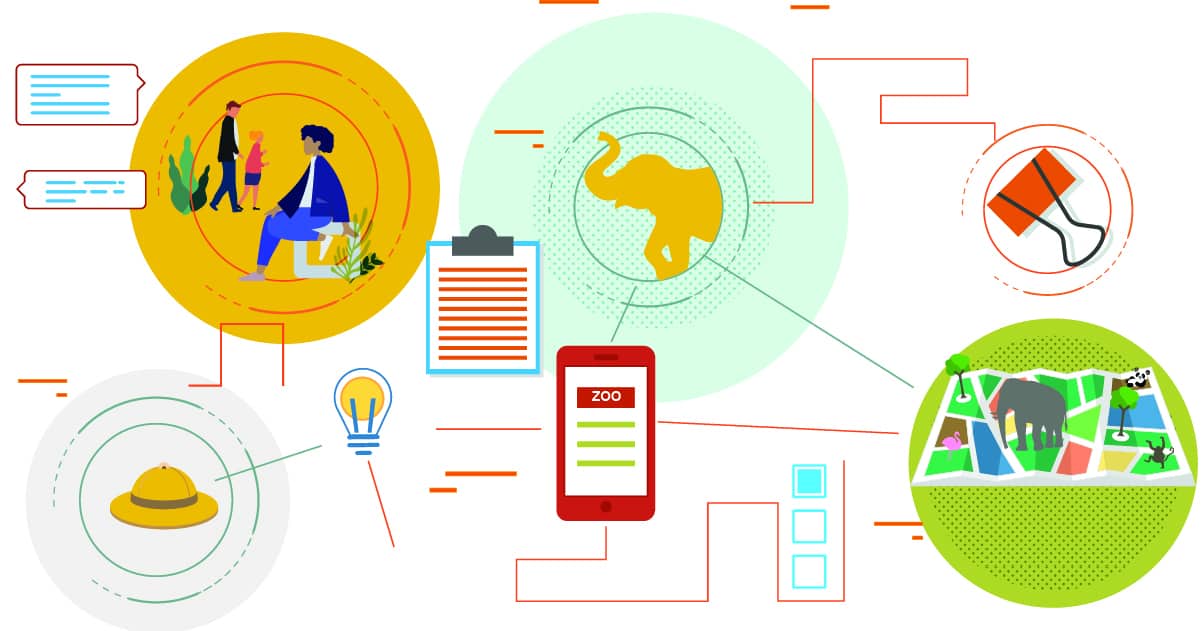
Author’s note:
Our next two posts are from when we visited zoo atlanta earlier this year. due to the covid-19 pandemic, many zoos and aquariums are running on a limited number of essential staff and providing “ virtual visits ” through webcams and live events. as service designers, we have a keen awareness of the power of place and delivery channels. we applaud the efforts of the continuing education and connection that virtual visits provide. while we do enjoy checking in on lun lun and yang yang on panda cam, we can’t wait to visit them in person soon., introduction.
A service safari is a method service designers use to evaluate service experiences in situ —going out to the location of the service and experiencing it themselves as a visitor, customer, user, etc. While many observational frameworks exist for use in ethnographic research, we wanted to develop one that emphasizes the most important aspects of service experiences. And what better location to test out a new framework for a service safari than at a zoo?
This experimental project is important and personal to me. I worked at the local zoo for over 10 years and later studied animal-computer interaction in graduate school. The zoo provided a familiar setting for me to test out our service safari framework, but the experience led to a more interesting design conundrum—addressing the role of non-human service actors (in an upcoming blog post – stay tuned).
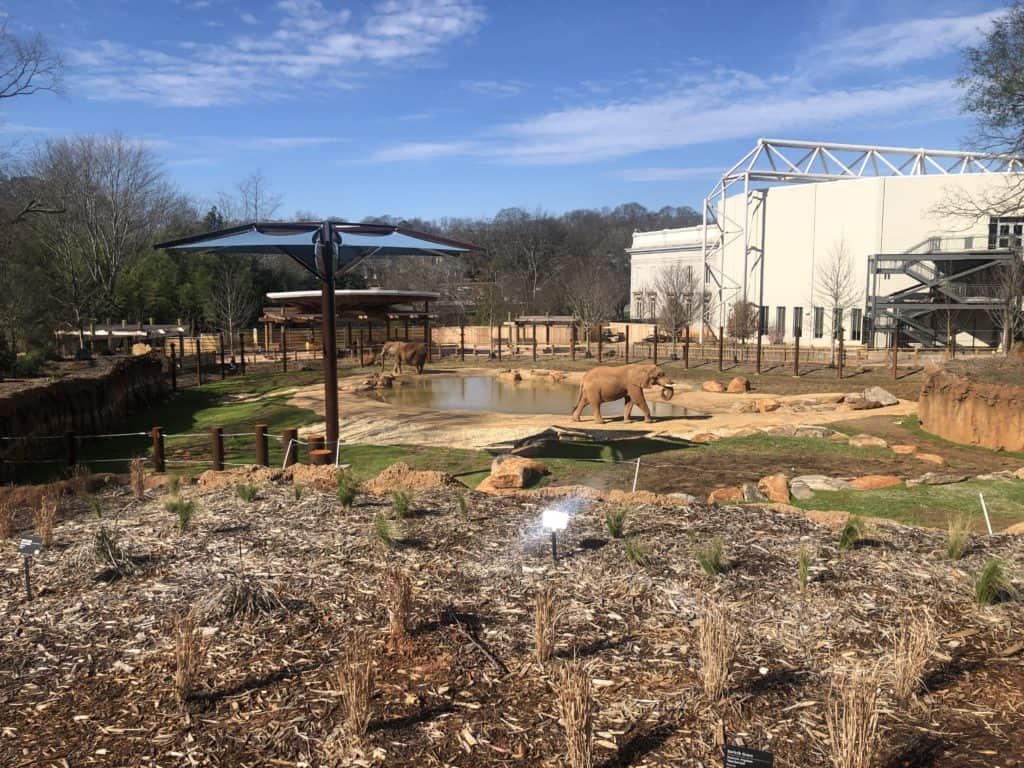
A New Framework
To prepare for our service safari, a small Harmonic team studied existing research methods and explored a few framework ideas, including one that spelled out TOFU BACON (catchy name, but too long). Taking into account service goals and past service safaris, we developed an observational research framework: TACIT (Touchpoint, Actor, Content, Interaction, Timing).
T: Touchpoint | Signage, cell phones, animals, interactive devices, exhibitry, talks. How do touchpoints support visitor needs?
A: Actor | Guests, volunteers, staff, and elephants (more on the elephants later)
C: Content | The information/ tone of the signs, websites, apps, talks, Q & A, etc. What does the content say, what are the qualities of the content, and what does it invoke?
I: Interaction | Can include people reading the sign, touching an interactive element (moving a sign), talking to a docent ?
T: Timing | Objectively in terms of minutes and hours, and subjectively in terms of patience and convenience. For each stage of the experience, approximately how long do tasks take?
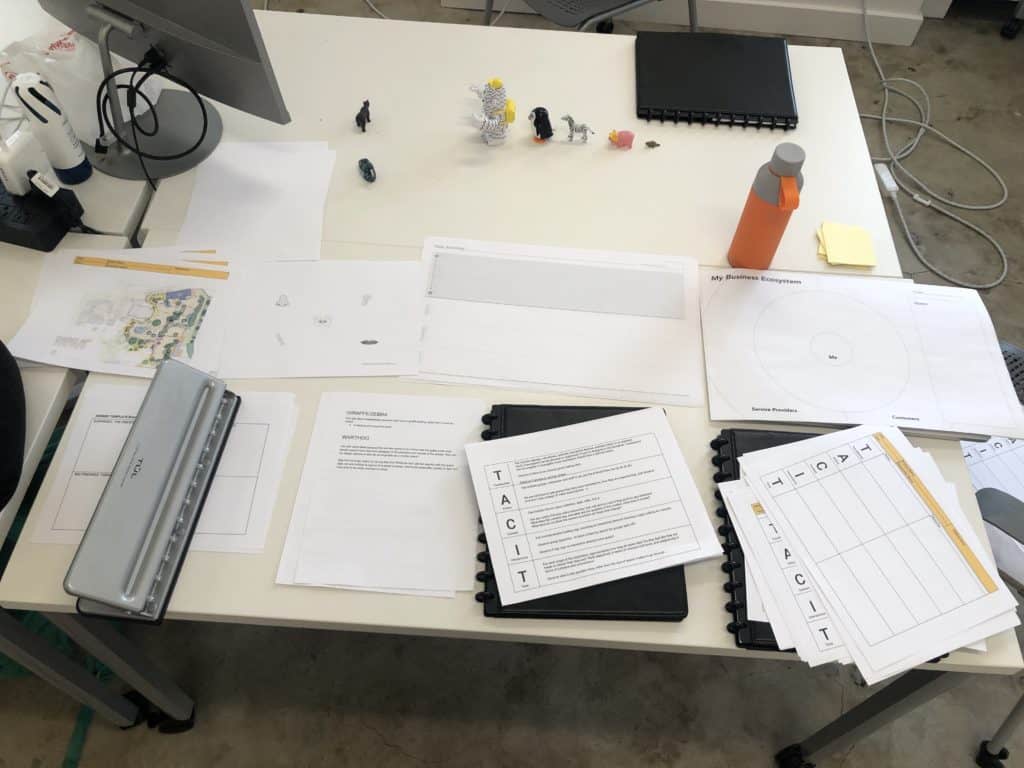
With that in mind, we created a service safari booklet with a section for notes, a site schematic, and a debrief form with prompts. Two coworkers and I went to the zoo and tested out our material. In regards to the TACIT framework, we realized that ‘content’ and ‘touchpoint’ often hit the same notes, and felt redundant. One suggestion was to change ‘content’ to ‘context’ to note qualities of the space—weather, amount of guests, and special activities.
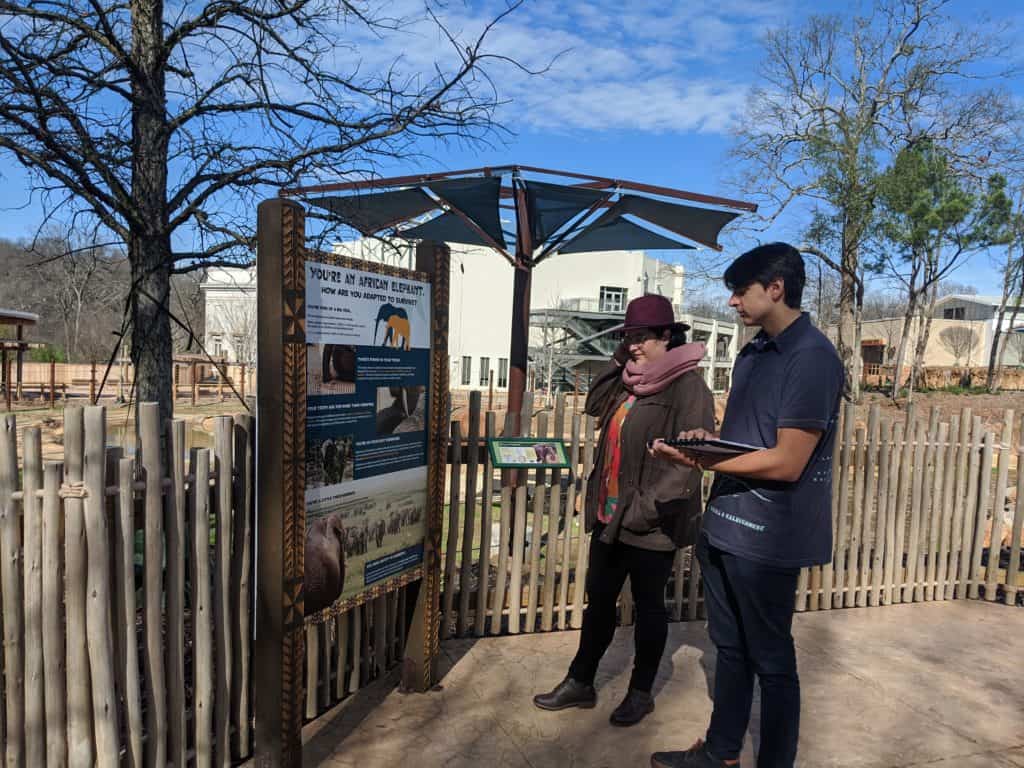
We’re still developing TACIT and have utilized the framework on other projects. With each use, we iterate on the categories, wording, and even the note-taking booklet design. After the visit, we collected our findings by mapping out observations, actors, and touchpoints onto the schematic. We rounded out this part of our exercise by noting our findings and presenting our board to the zoo’s designer. This method yielded several opportunities for more engaging touchpoints and demonstrated a new outside-in way for the zoo to consider the visitor experience when they have the chance to update or build exhibits in the future.
The setting inspired us to look at things from a different perspective at around 10 feet tall. In service design, we are able to look at solutions through many perspectives – employee, customer, and business. In the follow-up blog, The Elephant in the Blueprint , we examine service design tools and techniques through the perspective of the elephant.
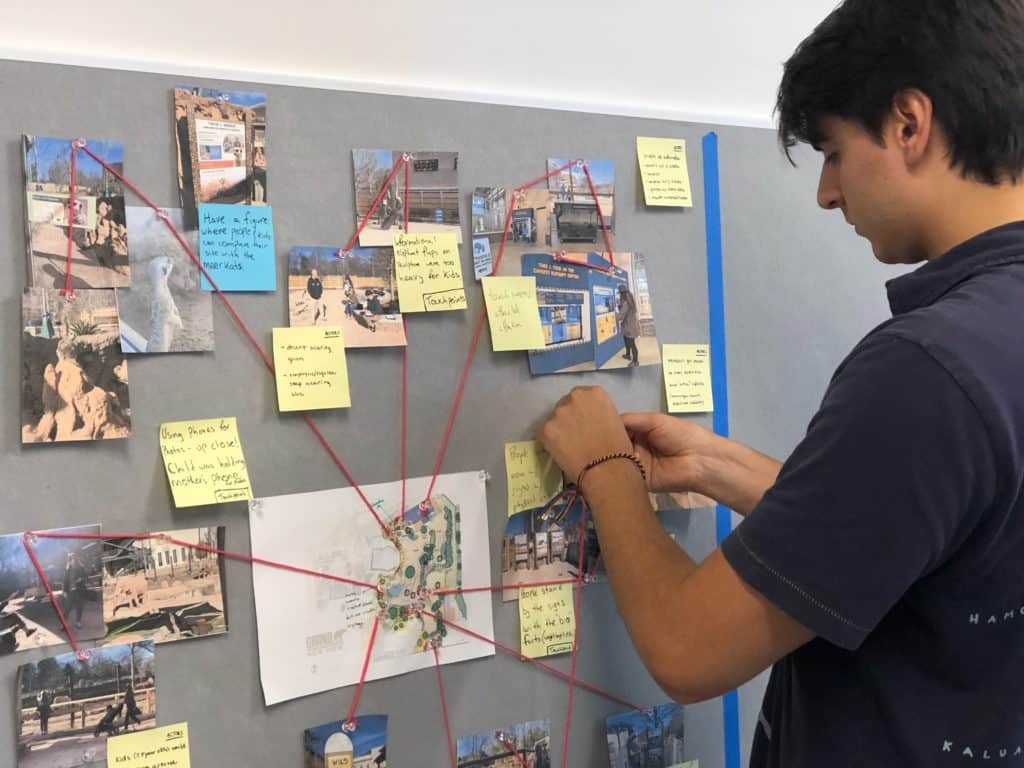
We recreated the visit by building out the exhibits via a method called spatial mapping.
Related Posts
Creating a culture of service orientation: unlocking greater value for all service participants.
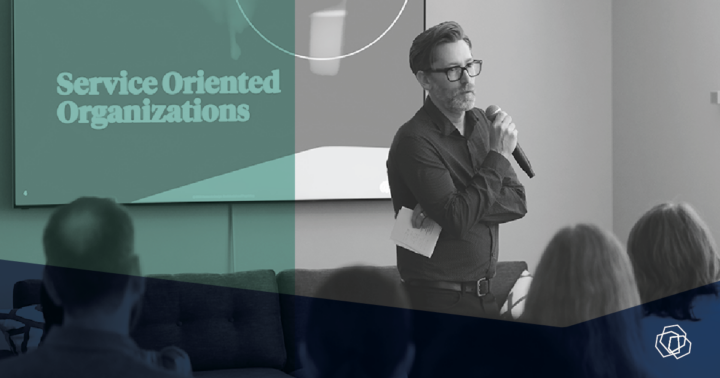
Design Philosophy: Conceptual Integrity and Empathic Anticipation

The Ecotone Framework: Understand Systemic Change and Innovation in Service Design
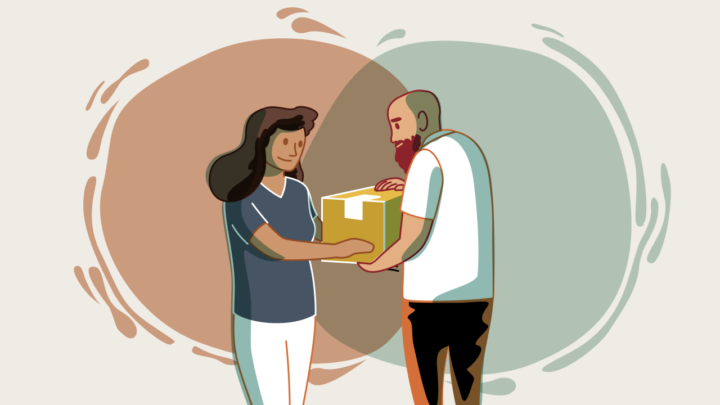

"Design like you’re right; listen like you’re wrong."
We need to prepare before the workshop by scouting suitable local services. Choose three or four different services unless we are targeting one particular type of service. For example there may be a local bike hire scheme or a specialist retail outlet to try. Or a bank, bus service or party planning agency to investigate.
Then we prepare envelopes with the different Service Safari missions and hand them out to workshop delegates along with the Service Safari tool for making notes and structuring their observations.
Small teams of 2-4 people then go off and experience their service, noting their experiences and taking photos or recordings as appropriate. An hour is usually sufficient for the fieldwork. When our explorers return they can then compare notes with other teams and draw conclusions that help the innovation process.
Sources: David Townson / Hope Valley College
HOW THIS TOOL FITS IN WITH OTHERS
Use Service Safari in a Prototyping Jam to learn how to analyse a service, or as a warm-up before creating a Service Blueprint .
Post a comment
You must be logged in to post a comment.
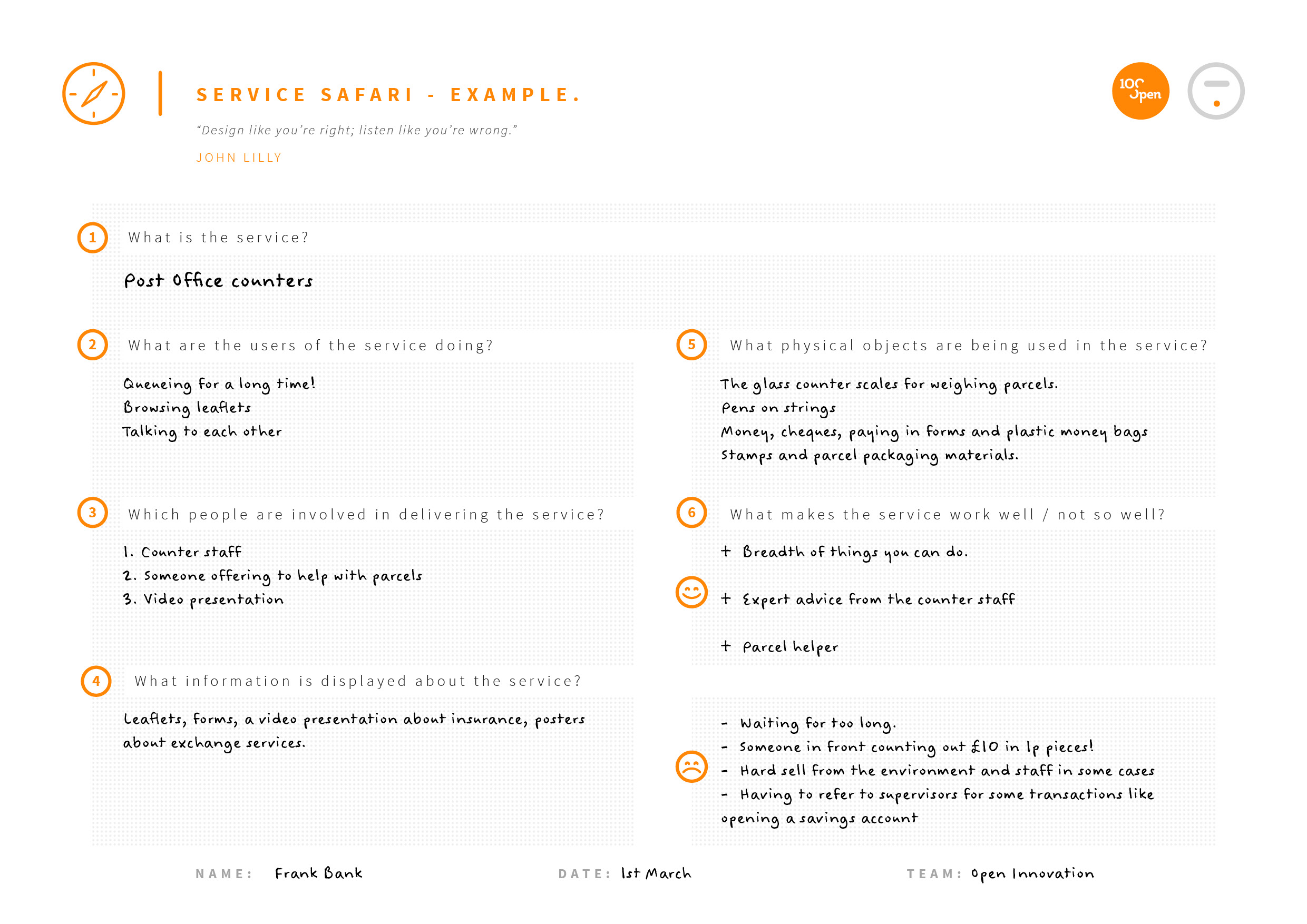
Sign up for 100%Open updates. View our SlideShare presentations.
Terms and conditions. Privacy policy.
100%Open, 3rd Floor, 86-90 Paul Street, London, EC2A 4NE [email protected] -->
We may be 100%Open but we are 100%committed to protecting your privacy. We will store any information that you’ve given us so we can keep you informed about 100%Open. If you’ve opted in or enquired, we’ll send you, as appropriate, invitations to Union events, newsletters or information about our services. We will never trade your personal information to third parties.
By submitting your data you agree to the terms of our Privacy Policy. See here Privacy Policy for the full monty.
Don't have an account yet? Register here for free.
- Buzzword Buster
Service Safari
Role of this tool.
Service Safari is an exercise that we can carry out when running a Prototyping Bootcamp . By going out, visiting a service and using it you will be able to understand how that service works and how it can be improved. This tool can either be used to get into the mindset of a service designer or to research a particular service innovation that we are focusing on.
How do we use it?
We need to prepare before the workshop by scouting suitable local services. Choose three or four different services unless we are targeting one particular type of service. For example there may be a local bike hire scheme or a specialty retail outlet to try. Or a bank, bus service or party planning agency to investigate.
Then we prepare envelopes with the different Service Safari missions and hand them out to workshop delegates along with the Service Safari tool for making notes and structuring their observations.
Small teams of 2-4 people then go off and experience their service, noting their experiences and taking photos or recordings as appropriate. An hour is usually sufficient for the fieldwork.
When our explorers return they can then compare notes with other teams and draw conclusions that help the innovation process.
Sources: David Townson / Hope Valley College
You must be logged in to download this tool
Worked Example
You must be logged in to download this worked example
2014 - 100%OPEN LTD
- Ts & Cs
- Subscription Offers
- Diversity, Equity & Inclusion at Delta
- Racial and Ethnic Diversity
- LGBTQ+ Diversity
- People with Disabilities
- Veterans and the Military
- Sustainability
- Awards & Recognition
- Global Partners
Delta is reinforcing its No. 1 position as the largest U.S. carrier to Africa this winter by relaunching daily* service to Lagos, Nigeria (LOS), from New York-JFK on Dec. 1. Fleet enhancements in service to Accra, Ghana (ACC), and South Africa are also underway.
The airline carries more than half a million customers between the U.S. and Africa each year on more than 34 weekly flights.
“These enhancements reflect our dedication to meeting the evolving needs of our customers,” said Joe Esposito, Delta’s Senior Vice President of Network Planning. “We’re expanding our options for customers to experience the premium service and elevated hospitality they expect from Delta.” Delta currently operates daily service between Atlanta and Lagos and, with the resumption of daily New York-JFK service, will offer a total of 14 weekly flights to Nigeria in December through the first half of January and 10 weekly flights for the remainder of winter 2024.
Customers on this flight will have a choice of Delta One, Delta Premium Select, Delta Comfort+ and Main Cabin experiences on the Airbus A330-200 . Once on board, customers in Delta One can look forward to an extensive food and beverage program that includes thoughtfully curated menu options, as well as specialty snacks and premium beer, wine and spirits. Customers flying in Delta Premium Select will have more space to relax and stretch out, with a wider seat, deeper recline, an adjustable footrest and leg rest.
All customers can enjoy a wide selection of in-flight entertainment options – movies, TV series, music, podcasts and more – via Delta Studio. Delta also partners with diverse suppliers worldwide for in-flight products such as artisan-crafted amenity kits and beverages like Thrive Farmers Tea.
Premium upgrades in service to Ghana and South Africa
As the first U.S. airline to initiate service to Ghana, Delta remains the largest operator in the U.S.-Ghana market, offering year-round daily service from New York-JFK.
Furthermore, in late October 2024, Delta will upgrade its aircraft serving Ghana to the 281-seat Airbus A330-900neo , adding nearly 1,000 more seats each week, providing 30% more capacity between Ghana and the U.S. The aircraft features four differentiated cabin experiences: Delta One Suites, Delta Premium Select, Delta Comfort+ and Main Cabin.
Delta One Suites feature a sliding door for enhanced privacy, memory-foam mattress and soft bedding made from recycled materials. Delta One customers can also enjoy more beverage options and a seasonal chef-curated four-course meal. Delta is also upgrading its aircraft from Atlanta to South Africa, where it operates 10 weekly flights year-round to Johannesburg (JNB) and Cape Town (CPT). With the introduction of the higher-premium 35H Airbus A350-900 , this upgrade will provide an additional eight Delta One Suite seats, bringing the total to 40, along with improved operational performance. Customers can look forward to these changes for JNB effective Jun. 20 and CPT on Sept. 9. For more information and to book travel, visit delta.com .
*This route will initially fly daily, shifting to three times per week on Jan. 16, 2025.
- John F. Kennedy International Airport (JFK)
- A330-900neo
Not finding what you need?
- Skip to global NPS navigation
- Skip to this park navigation
- Skip to the main content
- Skip to this park information section
- Skip to the footer section

Exiting nps.gov
Alerts in effect.
- Learn About the Park
- News Releases
News Release
Follow-up on fatal fall on mt. johnson.
Denali Park, AK – The body of a deceased climber was recovered from Mt. Johnson in Denali National Park and Preserve on Saturday morning, April 27. A team of two fell an estimated 1,000 feet while climbing the 8,400-foot peak the night of Thursday, April 25. Robbi Mecus, age 52 of Keene Valley, NY, died of injuries sustained in the fall. The surviving partner, a 30-year-old woman from California, sustained serious injuries and was rescued by NPS mountaineering rangers on Friday morning and flown by air ambulance to an Anchorage hospital. The two women were roped while climbing a steep route of mixed rock, ice, and snow on Mt. Johnson known as “the Escalator” when the accident occurred. Another climbing party on the peak witnessed the fall and notified park rangers. They then descended to the fallen climbers and confirmed that Mecus had died in the accident. The team tended to the injuries of the surviving climbing partner while trying to keep her warm throughout the night. The morning of Friday, April 26, Denali’s high altitude helicopter pilot and two mountaineering rangers rescued the injured climbing partner using a short-haul rescue technique. She was evacuated to Talkeetna, then flown to an Anchorage hospital for advanced medical care. Deteriorating weather conditions prevented the pilot and rangers from returning to the accident site on Friday. On Saturday morning at 8:00 am, weather permitted the park’s helicopter pilot and mountaineering rangers to return to Mt. Johnson to recover the body of the climber who perished in the fall. Denali National Park Superintendent Brooke Merrell said “We are grateful for the rescue efforts of Denali mountaineering rangers and the two good Samaritans on Mt. Johnson who helped save a fellow climber’s life. We extend our thoughts and condolences to the friends and family of Robbi Mecus”.
Last updated: April 27, 2024
Park footer
Contact info, mailing address:.
PO Box 9 Denali Park, AK 99755
907 683-9532 A ranger is available 9 am to 4 pm daily (except on major holidays). If you reach the voicemail, please leave a message and we'll call you back as soon as we finish with the previous caller.
Stay Connected
Secret Service removes agent from Kamala Harris' detail after 'distressing' behavior

WASHINGTON — A Secret Service special agent was removed from Vice President Kamala Harris' detail after having exhibited "distressing" behavior this week, a spokesperson confirmed Thursday.
The agent, whose identity has not been disclosed, had been involved with the Harris' departure from Joint Base Andrews, Maryland, on Monday morning, when Harris was headed to Wisconsin.
The agent "began displaying behavior their colleagues found distressing," Anthony Guglielmi, chief of communications for the Secret Service, said in a statement Thursday. "The agent was removed from their assignment while medical personnel were summoned."
Harris was not present when the incident took place. She was at the Naval Observatory, the vice president's residence, and Guglielmi said her departure was not affected.
“The U.S. Secret Service takes the safety and health of our employees very seriously,” Guglielmi said. “As this was a medical matter, we will not disclose any further details.”
Additional information about the incident, which was first reported by the Washington Examiner , was not released. The vice president's office did not comment Thursday.
Megan Lebowitz is a politics reporter for NBC News.
- Share full article
Advertisement
Supported by
Agent Removed From Harris’s Detail After ‘Distressing’ Behavior
The Secret Service agent was removed during an incident on Monday morning shortly before Vice President Kamala Harris left for a campaign event in Wisconsin.

By Hamed Aleaziz and Jazmine Ulloa
A U.S. Secret Service agent was removed from Vice President Kamala Harris’s security detail this week after the officer “began displaying behavior their colleagues found distressing,” an agency spokesman said on Thursday.
The incident happened Monday morning at Joint Base Andrews outside of Washington, shortly before Ms. Harris left for a campaign event in Wisconsin. A New York Times reporter who was among the media members traveling with Ms. Harris heard medical personnel trying to calm a person down at the scene. The incident was earlier reported by The Washington Examiner .
“At approximately 9 a.m. April 22, a U.S. Secret Service special agent supporting the vice president’s departure from Joint Base Andrews began displaying behavior their colleagues found distressing,” the Secret Service spokesman, Anthony Guglielmi, said in a statement.
“The agent was removed from their assignment while medical personnel were summoned,” Mr. Guglielmi said. He added that Ms. Harris was at the Naval Observatory in Washington, where the vice president lives, during the incident and that “there was no impact on her departure from Joint Base Andrews.”
Secret Service officials did not provide any further information on the incident, saying only that it was a “medical matter.”
Hamed Aleaziz covers the Department of Homeland Security and immigration policy. More about Hamed Aleaziz
Jazmine Ulloa is a national politics reporter for The Times, covering the 2024 presidential campaign. She is based in Washington. More about Jazmine Ulloa

This New Safari Lodge in Kenya Offers a Close-Up Look at Africa’s Last Remaining ‘Super Tusker’ Elephants
Opened in kenya’s first community-owned conservancy, angama amboseli pays homage to the large-tusked elephants that roam near the lodge..
- Copy Link copied

A guest suite at Angama Amboseli with views of Mt. Kilimanjaro
Sammy Njoroge/Angama Amboseli
The AFAR take
The 5,700-acre Kimana Sanctuary, Kenya’s first community-owned conservancy, is home to the Masai community and some of Africa’s last remaining super tusker elephants, who move between the nearby Chyulu Hills and Amboseli National Parks.
It is also the home of Angama Amboseli , which in October 2023 opened 10 suites styled in serene natural tones offset by stark modern blacks. The suites each feature outdoor showers, private verandas, and uninterrupted views of Mount Kilimanjaro, Africa’s tallest mountain. The sister property to Angama Mara (located in Kenya’s vast Masai Mara ecosystem, about 300 miles west), Angama Amboseli has an aesthetic that complements the environment: The round infinity pool sits above a lowered water trench from which resident elephants can drink; elephant dung is used to add texture to exterior walls; and a semicircle chartreuse sofa in the main lounge area is inspired by the leaves of the ubiquitous acacia trees.
Who’s it for?
Safari veterans looking to see rare birds and large-tusked elephants while learning how communities coexist with wildlife in this region.

Wildlife viewing at Angama Amboseli
Tanveer Badal
The location
Kimana Sanctuary is widely believed to be Kenya’s first community-owned sanctuary, meaning that it is owned by 844 local landlords who together make decisions on how the land is used. Today the sanctuary is exclusively available to guests of Angama Amboseli. Travelers can fly in from Nairobi to Amboseli National Park using a local carrier such as Safarilink. I arrived at the camp from Nairobi, where I’m based, after a smooth three-hour drive down Mombasa Highway; a few miles after we turned on to the quieter C102, a giraffe crossed the road, welcoming us to a wilder side of Kenya.
As Kimana is sandwiched between several larger parks, including Amboseli National Park, Tsavo West National Park, and the Chyulu Hills the sanctuary serves as a corridor for the area’s wildlife. The establishment of Angama in 2023, as well as the lodge’s long-term partnership with Big Life Foundation (a nonprofit conservation organization that focuses on collaborative wildlife management), helped to strengthen the sanctuary’s conservation efforts. In the main area at the lodge, staff members can walk guests through a giant stylized metal map with arrows depicting how animals, including long-tusked elephants, tend to move through the region.
One luxury of Angama Amboseli is its exclusivity: You can roll out of bed in your pajamas and be one of the few people to see the sunrise view of Mount Kilimanjaro. The only vehicles permitted in the 5,700-acre sanctuary are those from the lodge. Guests can do a safari at night, when a whole different set of fauna emerges.
For travelers looking for more of a traditional game drive, the staff can take people to the nearby Amboseli National Park. The Angama team is working to create a new gate by August 1 that would cut the travel time to the park in half, to 20 to 30 minutes. The national park is also home to a large elephant herd as well as resident cats and more than 600 species of birds, giraffes, and zebras.
Angama’s people-driven ethos extends to the surrounding community. Seventy percent of the staff are hired from the area’s villages and towns.
One of the most memorable aspects of Angama Amboseli is its design. The lodge is sleek and earthy, with a thoughtful use of materials, colors, and shapes. Neutrals contrast with occasional pops of color: a giant half-circle light-green sofa whose color mimics the acacia leaves, ochre tables and chairs that resemble the clay earth, and white globe lights.
Each of the 10 tents offers private indoor-outdoor living space and outdoor showers, and outside lounge areas look right onto Mount Kilimanjaro. Rooms are stocked with homemade snacks, decanted bottles of gin and whiskey, and painting supplies for visitors to use during their stay.
The pachyderm theme is omnipresent in the design. The spacious tents, when you squint, look like modern renderings of elephants. Elephant dung adds additional texture to some exterior walls. Below the rounded pool, elephants and other wildlife can drink from a unchlorinated trench.
The art gallery features paintings by Nairobi-based artist Sophie Walbeoffe that depict elephants, flamingos, and other famed residents of Amboseli National Park, as well as wildlife photography by Sammy Njoroge, who runs the lodge’s studio, and more. Njoroge and his team allow guests to rent DSLR cameras with zoom lenses, and after you return from a game drive, they can help edit your photos. Near the entrance, the lodge has displayed replica tusks of Tolstoy, one of the beloved local super tuskers that frequented Kimana Sanctuary until he was tragically killed in 2022 by poachers. Put together, his tusks weighed nearly 250 pounds, and the right one was more than 100 inches long.

A guest suite bedroom at Angama Amboseli
Brian Siambi/Angama Amboseli
The food and drink
The resident chefs can prepare anything from simple pastas to multicourse meals. Everything uses simple, fresh ingredients, many of which are locally sourced. I enjoyed the lavish breakfast spread with homemade granola, and at other meals I gravitated toward soups made from seasonal vegetables, and fresh bread served alongside the beautiful main dishes. If guests are celebrating a special occasion, staff can arrange a meal in the property’s art gallery, where diners can enjoy a candlelit meal among elephant-themed paintings.
Staff and service
Before opening Angama Amboseli, staff spent three months training at sister property Angama Mara in the Masai Mara. Every guest is assigned a personal butler throughout their stay who can liaise with the staff regarding food preferences, drinks, and overall itinerary.
“We believe it’s about the people first,” says Collins Randiga, general manager of Angama Amboseli. “We take care of our guests. We also make sure that our team sleeps well, has good food, and that their families are taken care of.” Every staff member is given two weeks off after working for six (this is approximately double compared to similar lodges nearby, based on three places I asked on recent safari visits). The staff quarters are built to the same standard as guest accommodations.
Angama’s people-driven ethos extends to the surrounding community. Seventy percent of the staff are hired from the area’s villages and towns. When I visited, the lodge manager, despite not hailing from the community himself, was going to pay his respects at the funeral for a family member of one of the 844 landlords that own the land. The first day of business, Angama Amboseli hosted some of the area’s elders so they could experience, enjoy, and bless the property.

Left, the pool at Angama Amboseli; right, a portrait of an elephant in a public area of the lodge
Courtesy of Angama Amboseli
Accessibility
One suite is called the Patty, named after sister property Angama Mara’s first guest to use a wheelchair, and features ramps, a lowered vanity, and grab rails in the bathroom. However, the main dining and lounge areas in the lodge have several stairs, which may be challenging for travelers with limited mobility.
Wildlife watch
Salash Johnson, our driver and guide, was the most knowledgeable guide I’ve ever had on a safari. Prior to working with Angama Amboseli, he was a ranger with the Kenya Wildlife Services for seven years. With him, I learned about the great efforts rangers take to protect the area’s wildlife, particularly the elephants with characteristically large tusks that are more vulnerable to poachers. He became visibly emotional when he drove me to Tolstoy’s final resting place and explained how much the rangers had tried to protect him. His hope now is that, with Angama leasing the land and offering jobs to community members, there may be more of an incentive to protect elephants from poaching. From $1,650/person/night

Where are the cicadas? Use this interactive map to find Brood XIX, Brood XIII in 2024
In a few weeks, over a dozen states will be abuzz as trillions of periodical cicadas will emerge from their yearslong underground stay.
Broods XIX and XIII will emerge in a combined 17 states, mostly in the Midwest and Southeast, in a rare, double brood event . These two broods last emerged together 221 years ago, and after this year are not predicted to do so again until 2245.
Once conditions are right, the two broods will emerge in massive numbers to feed, make noise, mate and die. Here's what to know about where to find the 13-year Brood XIX and the 17-year Brood XIII.
2024 double cicada broods: Check out where Broods XIII, XIX will emerge
The two cicada broods will emerge in a combined 17 states across the Southeast and Midwest, with an overlap in parts of Illinois and Iowa. They will emerge once soil eight inches underground reaches 64 degrees, expected to begin in mid-May and lasting through late June.
The two broods last emerged together in 1803 , when Thomas Jefferson was president.
What is a periodical cicada?
Both the 13-year Brood XIX and the 17-year Brood XIII are periodical cicadas, which emerge every 13 or 17 years across North America. They differ from annual cicadas, which emerge every year.
You may remember the last periodical brood to emerge in huge numbers: the 17-year Brood X that was found in 2021 throughout the Midwest and Eastern Seaboard.
Annual cicadas, which are dark green to black with green wing veins, are typically larger than periodical cicadas , which are recognizable for their red eyes, red legs and red wing veins, according to North Carolina State University Extension.
Periodical cicadas emerge earlier, usually in mid-to-late May as opposed to annual cicadas in July and August. According to North Carolina State University Extension, annual cicadas begin mating, " singing conspicuously " and lying eggs about two weeks after they emerge. Their first nymphs will fall to the ground and begin feeding on roots under the soil, and fully-developed nymphs will emerge two years later and molt into adults.
Above ground, periodical cicadas have a similar life cycle, appear in much larger numbers and are much louder. At the end of their season, the next generation of nymphs move underground and remain for either 13 or 17 years.

IMAGES
VIDEO
COMMENTS
Called a Service Safari, it's an exploration of a service from a customer experience perspective. The method captures the real-world experience of a specific service, type of service, or a wider range of services, be that for booking train tickets, or a hotel or shopping mall experience, to a car hire or passport renewal service.
Called a Service Safari, it's an exploration of a service from a customer experience perspective. The method captures the real-world experience of a specific service, type of service, or a wider ...
A Service Safari helps researchers gauge customer emotions, reactions, and employee expressions during service interactions. Identifying emotions can provide valuable insights into how customers perceive a service and whether they feel satisfied or frustrated. Identifying Potential Customer Needs: Researchers can identify unmet or unexpressed ...
A service safari is a foundation for ethnographic research, not a replacement. Safaris reveal issues that inform later research questions. If a service safari is the only research used, it will be biased and unreliable. Keep an open and critical mind. An open mind is essential for stakeholders conducting service safaris of their services.
A service safari allows design teams better to understand competitors, users, and their own product. This service experience offers valuable insights for very little investment, making it an essential tool during the early stages of the design thinking process.. This article looks at the pros and cons of a service safari, how to plan and run one, and what you can expect from the results.
Service Safari is a research tool that helps designers develop interesting insights and inspirations by experiencing a service in first-person, as they were 'in the shoes' of a user. While pretending to be a user, designers can understand in detail all the aspects of the interaction with the service, observe how other people in the same ...
Service safari is a great research method which allows you to look across all channels and deep dive into a project or subject area. It allows you to walk in the footsteps of users, experiencing a task, product or service as near as possible to how they would. Through direct experience, you can assess where the strengths and weaknesses are.
Service safari is a prominent design methodology amongst service designers, but recently, UX researchers have also found this methodology quite useful. Service Safari is an exploration of service from a customer experience perspective. This methodology is best used at the very beginning of the design process to understand the real-world ...
Service Safari is a research technique involving direct observation of users as they interact with a specific service. Unlike other research methodologies, Service Safari focuses on user experience in real-world situations, allowing researchers to capture valuable and authentic insights.
A service safari is a method service designers use to evaluate service experiences in situ — going out to the location of the service and experiencing it themselves as a visitor, customer, user, etc.While many observational frameworks exist for use in ethnographic research, we wanted to develop one that emphasizes the most important aspects of service experiences.
This short video gives an overview of the Service Safari, a research technique that helps organisations to better understand the experience encountered when ...
Service safari provides a holistic view of the service environment, which can be especially important for understanding complex services. In addition, researchers can apply this methodology to competitor's services to gather intelligence about how their services operate and then compare this to their targeted service.
A service safari is a method service designers use to evaluate service experiences in situ —going out to the location of the service and experiencing it themselves as a visitor, customer, user, etc. While many observational frameworks exist for use in ethnographic research, we wanted to develop one that emphasizes the most important aspects ...
Note: A service safari is a method designers use to experience what a service feels like as a customer. I hope to keep a diary of these experiences to help me have empathy for customers and give ...
A service safari is undertaken to start the mapping process and is a great way to begin engaging cross functional groups to share ownership of improving experiences.
Service Safari is an event that encourages employees from all levels of an organization to shadow customer-facing employees and observe their interactions with customers. The goal of this exercise is…
Service Safari----Follow. Written by Clockwork Belgium. 18 Followers. The UX & Service Design Agency of the Ordina group. Creating better experiences through a human-centric, value-driven design ...
Ireland. +1 888 917 7480. Hours. A Service Safari is a powerful service design research method to build Customer Empathy. It allows you to walk in the shoes of your customer and experience what they experience in context and in-the-moment. Our Mobile Ethnography App and Journey Mapping Software make it easy to conduct service safar.
Service Safari is an exercise that enables us to understand how services work and to diagnose how they can be improved. By going out, visiting and using a service we can draw structured conclusions that help us create an effective service innovation. "Design like you're right; listen like you're wrong." We need to prepare before the ...
This is an example of doing a service safari. The example is the commuter experience of a public transport park n ride facility in Brisbane.
Role of this tool. Service Safari is an exercise that we can carry out when running a Prototyping Bootcamp. By going out, visiting a service and using it you will be able to understand how that service works and how it can be improved. This tool can either be used to get into the mindset of a service designer or to research a particular service ...
In 1938, it was granted town status. [citation needed]Administrative and municipal status. Within the framework of administrative divisions, it is incorporated as Elektrostal City Under Oblast Jurisdiction—an administrative unit with the status equal to that of the districts. As a municipal division, Elektrostal City Under Oblast Jurisdiction is incorporated as Elektrostal Urban Okrug.
Safari services llc. 269 likes. Pool service, maintenance, installation
As the first U.S. airline to initiate service to Ghana, Delta remains the largest operator in the U.S.-Ghana market, offering year-round daily service from New York-JFK. Furthermore, in late October 2024, Delta will upgrade its aircraft serving Ghana to the 281-seat Airbus A330-900neo , adding nearly 1,000 more seats each week, providing 30% ...
Date: April 27, 2024 Contact: Paul Ollig, 907-683-9531 Denali Park, AK - The body of a deceased climber was recovered from Mt. Johnson in Denali National Park and Preserve on Saturday morning, April 27. A team of two fell an estimated 1,000 feet while climbing the 8,400-foot peak the night of Thursday, April 25. Robbi Mecus, age 52 of Keene Valley, NY, died of injuries sustained in the fall.
WASHINGTON — A Secret Service special agent was removed from Vice President Kamala Harris' detail after having exhibited "distressing" behavior this week, a spokesperson confirmed Thursday.
A U.S. Secret Service agent was removed from Vice President Kamala Harris's security detail this week after the officer "began displaying behavior their colleagues found distressing," an ...
This New Safari Lodge in Kenya Offers a Close-Up Look at Africa's Last Remaining 'Super Tusker' Elephants ... Staff and service. Before opening Angama Amboseli, staff spent three months training at sister property Angama Mara in the Masai Mara. Every guest is assigned a personal butler throughout their stay who can liaise with the staff ...
2024 double cicada broods: Check out where Broods XIII, XIX will emerge. The two cicada broods will emerge in a combined 17 states across the Southeast and Midwest, with an overlap in parts of ...
An institution's responsibilities regarding service providers are outlined at 16 C.F.R. 314.4(f), which requires the institution to oversee service providers by: Taking reasonable steps to select and retain service providers that are capable of maintaining appropriate safeguards for the customer information at issue;